QuickLinks:
2000, 2001, 2002, 2003, 2004, 2005, 2006, 2007, 2008, 2009, 2010, 2011, 2012,
2013, 2014, 2015, 2016, 2017, 2018, 2019, 2020, 2021, 2022, 2023, 2024, 2025,
2026, 2027, 2028, 2029, 2030, 2031, 2032, 2033, 2034, 2035, 2036, 2037, 2038,
2039, 2040, 2041, 2042, 2043, 2044, 2045, 2046, 2047, 2048, 2049
Page last updated Mar 13, 2020
Updated title formatting, checked Corwin positions
WORKING 2018+: Adding IDs, pix, tags, captions
Added Dreyer entries, checked updated Steinicke historical entries (lots of Dunlop queries)
Checked for mis-spelling of DeLisle Stewart
NGC 2000 (an OCL in the Large Magellanic Cloud = "PGC 3518061")
(also known as ESO 056-SC135 and SL 493)
Discovered (Feb 8, 1836) by John Herschel
A magnitude 11.9 open cluster in Mensa (RA 05 27 30.7, Dec -71 52 47)
Historical Identification: Per Dreyer, NGC 2000 (= GC 1203 = JH 2889, 1860 RA 05 29 45, NPD 161 58.6) is "faint, pretty large, round, a very little brighter middle". The position precesses to RA 05 27 27.3, Dec -71 52 12, on the northern rim of the cluster listed above and there is nothing comparable nearby, so the identification is certain.
Note About PGC Designation: For purposes of completeness LEDA assigns a PGC designation to all NGC objects, even if they are not galaxies, whence the designation shown in the title of this entry; but a search of the database for that designation returns no result, so it has been placed in quotes.
Physical Information: NGC 2000 is in the Large Magellanic Cloud, which is about 160 to 165 thousand light years away. Given that and its apparent size of about 1.25 to 0.75 arcmin (from the images below), the cluster is about 60 light years across.
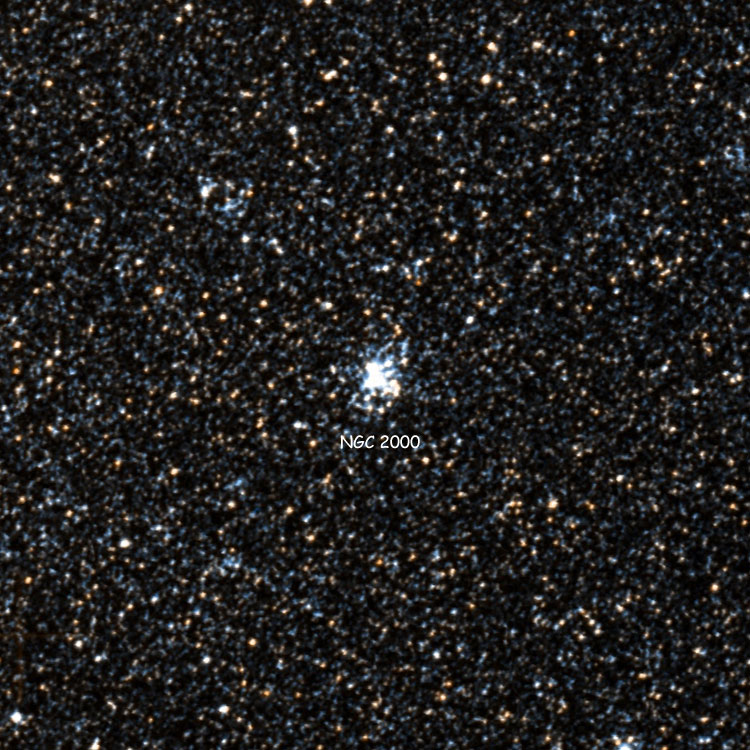
Above, a 12 arcmin wide DSS image centered on NGC 2000
Below, a 2.4 arcmin wide DSS image of the cluster

Below, a 1 degree wide DSS image showing the location of the cluster relative to the LMC

Below, a 2 degree wide DSS image showing the location of the cluster relative to the LMC

NGC 2001 (an OCL in the Large Magellanic Cloud = "PGC 3518062")
(also known as ESO 056-SC137, SL 507 and part of LH 64)
Discovered (Sep 27, 1826) by James Dunlop
Also observed (Dec 30, 1836) by John Herschel
A magnitude 9.5 open cluster in Dorado (RA 05 29 04.0, Dec -68 46 42)
Historical Identification: Per Dreyer, NGC 2001 (= GC 1204 = JH 2888, Dunlop 178??, 1860 RA 05 29 51, NPD 158 50.9) is "a cluster, stars of 13th magnitude". The position precesses to RA 05 29 03.2, Dec -68 44 41, within the northwestern part of the widely scattered cluster listed above, so there is little doubt of the identification.
Discovery Note: Steinicke lists this as Dunlop 136, not Dunlop 178. (source?)
Note About PGC Designation: For purposes of completeness LEDA assigns a PGC designation to all NGC objects, even if they are not galaxies, whence the designation shown in the title of this entry; but a search of the database for that designation returns no result, so it has been placed in quotes.
Physical Information: NGC 2001 is an open cluster in the Large Magellanic Cloud, consisting of a multitude of faint stars extending northeast-southwest along a roughly elliptical region of about 7 by 3.5 arcmin apparent size (from the images below, taking into account Gottlieb's observations). Given that and the 160 to 165 thousand light year distance of the LMC, the loose grouping is about 330 to 335 light years across. NGC 2001 is listed as part of Lucke-Hodge stellar association 64, along with ANONb4 and e135.
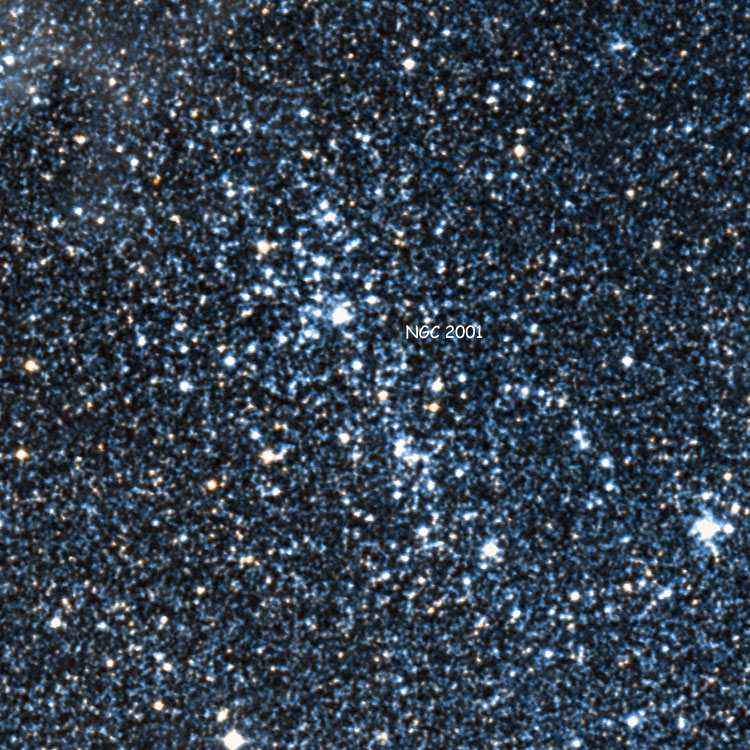
Above, a 12 arcmin wide DSS image centered on NGC 2001
Below, an 8 arcmin wide DSS image of the loose cluster

Below, a 1 degree wide DSS image showing the location of the cluster relative to the LMC

Below, a 2 degree wide DSS image showing the location of the cluster relative to the LMC

NGC 2002 (an OCL in the Large Magellanic Cloud = "PGC 3518063")
(also known as ESO 086-SC3 and SL 517)
Discovered (Sep 24, 1826) by James Dunlop
Also observed (Dec 20, 1835) by John Herschel
A magnitude 10.1 open cluster in Dorado (RA 05 30 20.6, Dec -66 53 04)
Historical Identification: Per Dreyer, NGC 2002 (= GC 1205 = JH 2890, Dunlop 214?, 1860 RA 05 30 25, NPD 156 59.2) is "very bright, small, round, double star plus nebula in very large cluster". The position precesses to RA 05 30 19.4, Dec -66 53 10, within the southwestern rim of the cluster listed above, the description fits (though see the Discovery Note below) and there is nothing comparable nearby, so the identification is certain.
Discovery Note: There is some confusion about how NGC 2002 should be defined, not due to Dunlop's observation, but to the two observations made by Herschel. In Sweep 658 of Dec 20, 1835 (the one used as the date of his observation above) he writes "Place of a double star of class I (h 3779), the chief (brightest) of a great cluster of small (faint) stars loose and filling the field. It is the forerunner of the great cluster-region of the nubecula." In this case h 3779 does not mean entry 3779 in his catalog of clusters and nebulae, but entry 2217 (labeled as h 3779) in his catalog of double and multiple stars; but no currently available photograph shows the double, so all we can do is assume that it is in the cluster listed above, and wait for someone to use the HST or some similar telescope to obtain far better images of the object.
In Herschel's second observation, in Sweep 760 of Jan 2, 1837, he writes "Very bright, small, round. Here comes on the richest and brightest part of the starry and clustering portion of the nubecula." Up to this point we can presume that he is talking about the cluster of faint stars mentioned in the previous sweep, but instead of discussing the double star, is describing the cluster as a whole. However, Herschel noticed the discrepancy in the two descriptions and added "Note: From this object being described at one time as a double star, and at another as a nebula, it is probable that it is in one of those singular close-knotted groups which especially characterize the nubeculae," the last word undoubtedly referring to both the Large and Small Magellanic Clouds.
Herschel's note has led to some concern about whether his observations refer only to the cluster listed above, or in some way to the whole region filled with clusters of various sizes and types; but since his position falls exactly on the cluster listed above, and he accepted Dunlop's observation of the region as pointing to the same object, it seems reasonably certain that despite the uncertainty placed by his notes in our minds, NGC 2002 must be treated as being only the one cluster, and the comments about the numerous "knots" simply a comment on how complex the whole region appears.
Note About PGC Designation: For purposes of completeness LEDA assigns a PGC designation to all NGC objects, even if they are not galaxies, whence the designation shown in the title of this entry; but a search of the database for that designation returns no result, so it has been placed in quotes.
Physical Information: NGC 2002 is located in the Large Magellanic Cloud, which is about 160 to 165 thousand light years away. Given that and its apparent size of about 1.2 arcmin (from the images below), it is about 55 light years across. NGC 2002 is listed as part of Lucke-Hodge stellar association 77, along with NGC 2006, 2027 and 2034, and SL objects 538, 582 and 586.

Above, a 12 arcmin wide DSS image centered on NGC 2002, also showing NGC 2006
Below, a 3 arcmin wide DSS image of the cluster
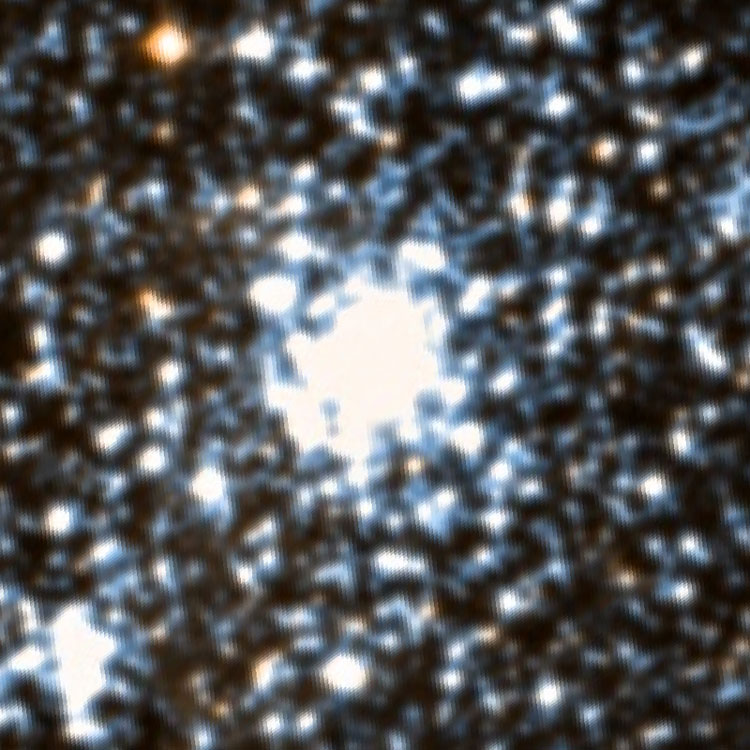
Below, a 1 degree wide DSS image showing the location of the cluster relative to the LMC
Also shown are NGC 2003, 2004 and 2006

Below, a 2 degree wide DSS image showing the location of the cluster relative to the LMC
Also shown are NGC 2003, 2004, 2006, 2011, 2014 and 2020

NGC 2003 (an OCL in the Large Magellanic Cloud = "PGC 3518064")
(also known as ESO 086-SC006 and SL 526)
Possibly observed (Nov 6, 1826) by James Dunlop
Discovered (Nov 23, 1834) by John Herschel
A magnitude 11.3 open cluster in Dorado (RA 05 30 54.4, Dec -66 27 59)
Historical Identification: Per Dreyer, NGC 2003 (= GC 1206 = JH 2981, (Dunlop 184?), 1860 RA 05 30 50, NPD 156 34.1) is "bright, small, stellar, mottled but not resolved". The position precesses to RA 05 30 53.0, Dec -66 28 10, on the southwestern rim of the cluster listed above, the description fits and there is nothing comparable nearby so the identification is certain.
Discovery Note: As pointed out by Gottlieb (and correctly listed in Steinicke), this is JH 2891, not JH 2981, as incorrectly stated in the GC and NGC. Steinicke lists this as Dunlop 239, not Dunlop 184. (source?)
Note About PGC Designation: For purposes of completeness LEDA assigns a PGC designation to all NGC objects, even if they are not galaxies, whence the designation shown in the title of this entry; but a search of the database for that designation returns no result, so it has been placed in quotes.
Physical Information: NGC 2003 is in the Large Magellanic Cloud, which is about 160 to 165 thousand light years away. Given that and its apparent size of about 1.75 by 0.9 arcmin (from the images below), the cluster is about 80 to 85 light years across.
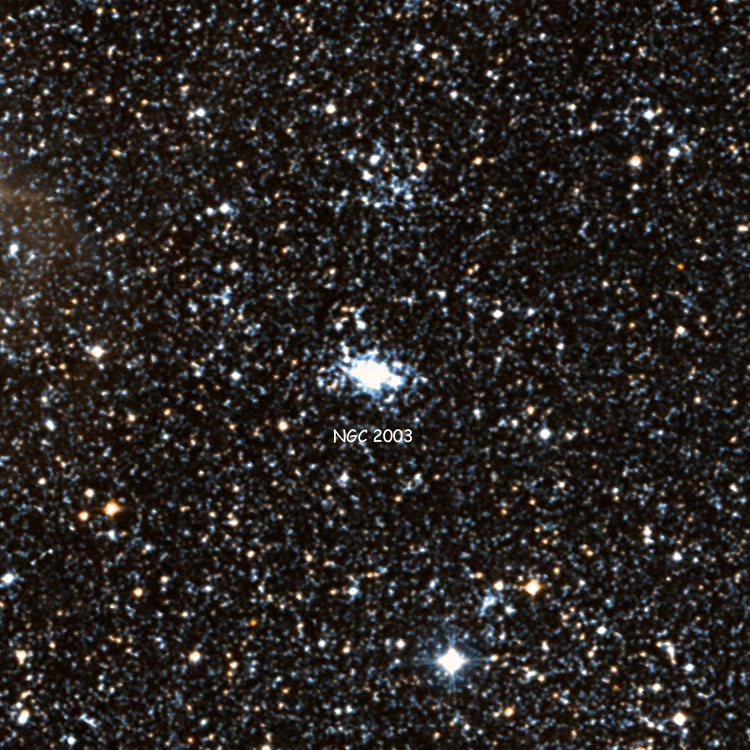
Above, a 12 arcmin wide DSS image centered on NGC 2003
Below, a 2.4 arcmin wide DSS image of the cluster

Below, a 1 degree wide DSS image showing the location of the cluster relative to the LMC
Also shown are NGC 2002 and the northern half of NGC 2006

Below, a 2 degree wide DSS image showing the location of the cluster relative to the LMC
Also shown are NGC 2002, 2004 and 2006
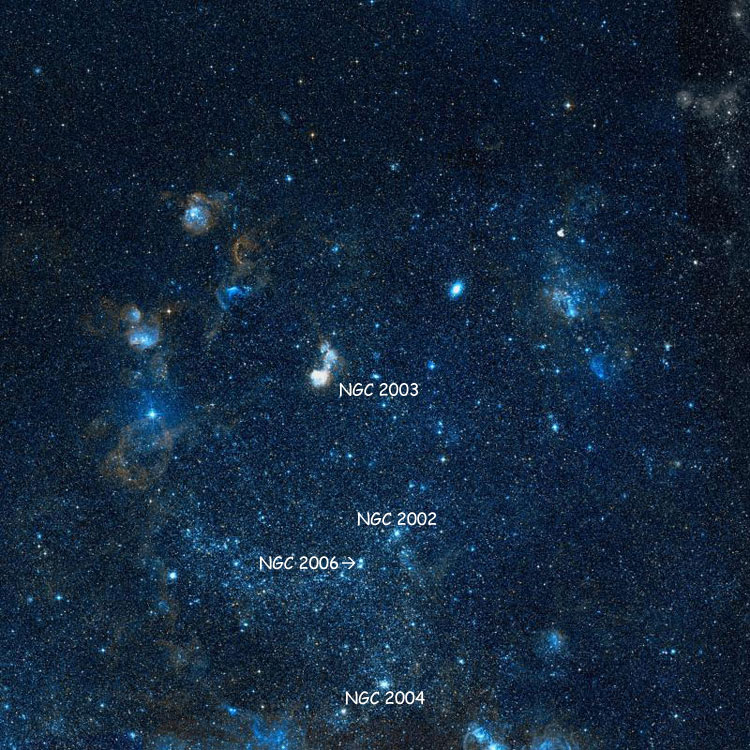
NGC 2004 (an OCL in the Large Magellanic Cloud = "PGC 3518065")
(also known as ESO 086-SC004 and SL 523)
Discovered (Aug 3, 1826) by James Dunlop
Also observed (Nov 2, 1834) by John Herschel
A magnitude 9.6 open cluster in Dorado (RA 05 30 40.7, Dec -67 17 15)
Historical Identification: Per Dreyer, NGC 2004 (= GC 1207 = JH 2893, Dunlop 215, 1860 RA 05 30 55, NPD 157 23.3) is "a globular cluster, bright, pretty large, pretty rich, compressed, stars of 12th magnitude". The position precesses to RA 05 30 40.7, Dec -67 17 21, right on the object listed above, the description fits and there is nothing comparable nearby, so the identification is certain.
Discovery Note: Steinicke lists this as Dunlop 191, 215 and 216.
Note About PGC Designation: For purposes of completeness LEDA assigns a PGC designation to all NGC objects, even if they are not galaxies, whence the designation shown in the title of this entry; but a search of the database for that designation returns no result, so it has been placed in quotes.
Physical Information: NGC 2004 is an open cluster (albeit one that is sufficiently round and compact that it could be easily taken for a globular cluster with visual observations) in the Large Magellanic Cloud, which is about 160 to 165 thousand light years away. Given that and its apparent size of about 1.65 by 1.55 arcmin (from the images below), it is about 75 to 80 light years across.
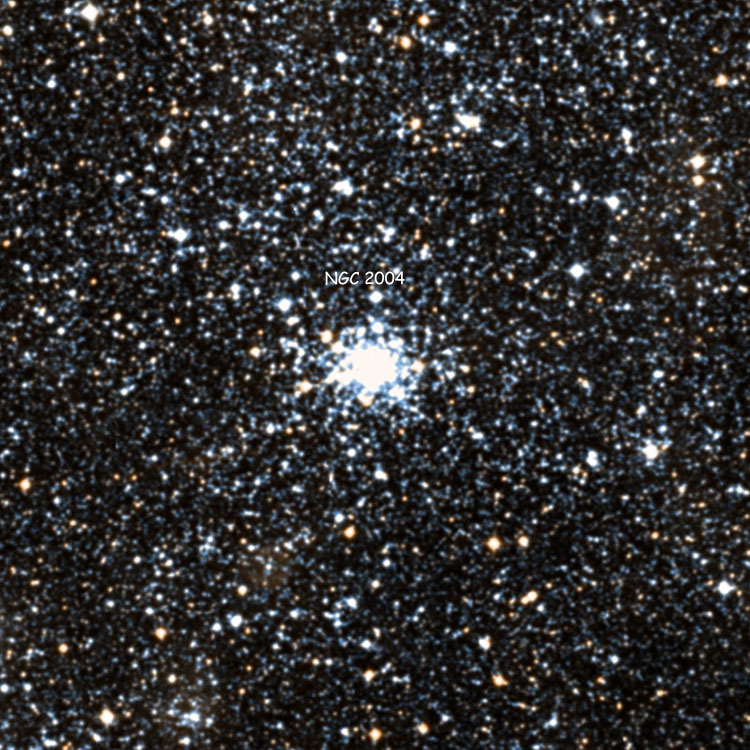
Above, a 12 arcmin wide DSS image centered on NGC 2004
Below, a 2.75 arcmin wide DSS image of the cluster
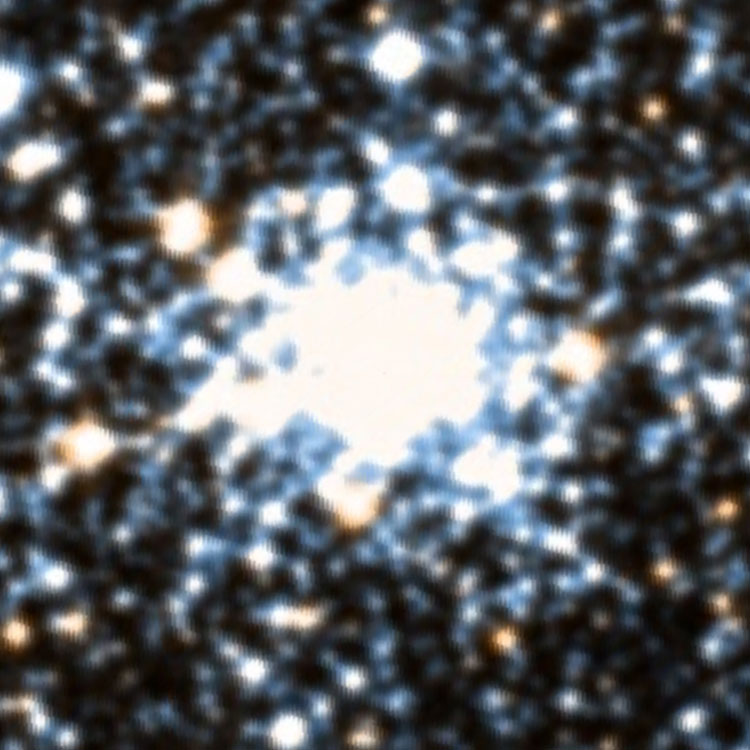
Below, a 0.9 by 0.6 arcmin wide HST image of part of the cluster (Image Credit Hubble Legacy Archive)
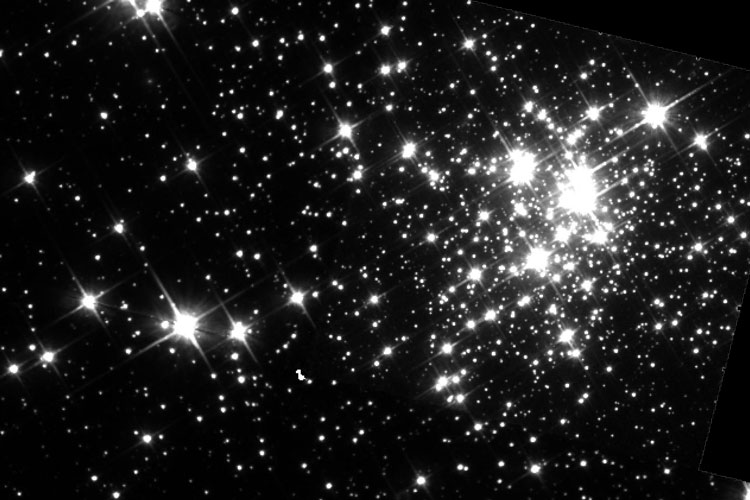
Below, a 1 degree wide DSS image showing the location of the cluster relative to the LMC
Also shown are NGC 2002, 2006, 2011, 2014 and 2020
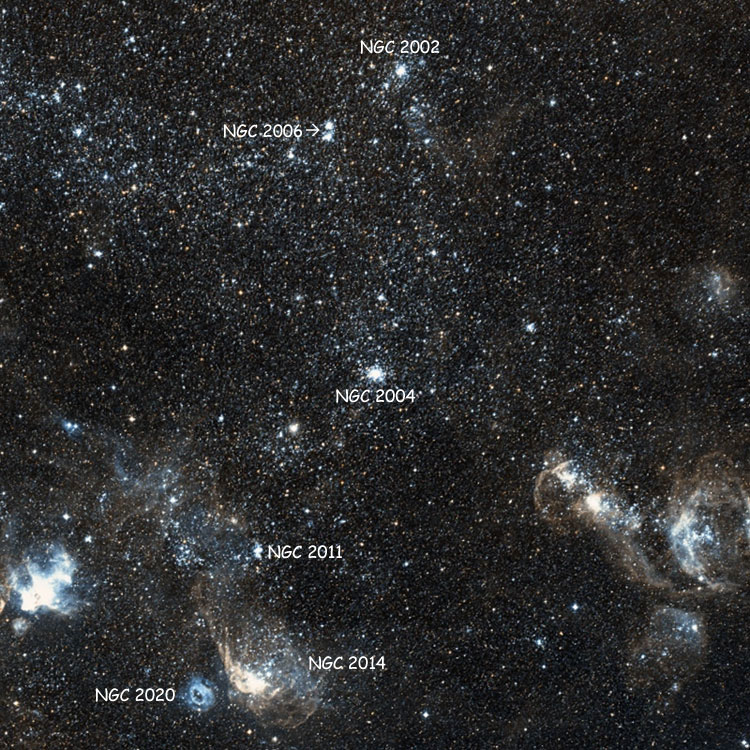
Below, a 2 degree wide DSS image showing the location of the cluster relative to the LMC
Also shown are NGC 2002, 2003, 2006, 2011, 2014 and 2020
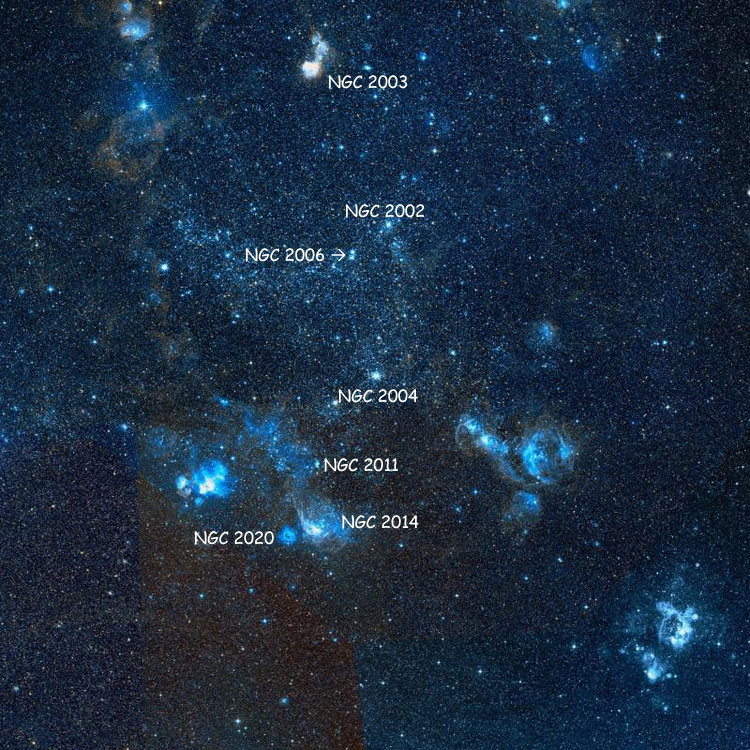
NGC 2005 (a GCL in the Large Magellanic Cloud = PGC 2802633)
(also known as ESO 056-SC138 and SL518)
Discovered (Sep 24, 1826) by James Dunlop
Also observed (Nov 1836 to Mar 1837) by John Herschel
A magnitude 11.5 globular cluster in Dorado (RA 05 30 10.3, Dec -69 45 10)
Historical Identification: Per Dreyer, NGC 2005 (= GC 1208 = JH (509), (Dunlop 138), 1860 RA 05 31 23, NPD 159 51.3) has "no description, in Nubecula Major", Nubecula Major being the Large Magellanic Cloud. The position precesses to RA 05 30 08.6, Dec -69 45 21, right on the cluster listed above, and there is nothing comparable nearby, so the identification is certain.
Note About PGC Designation: For purposes of completeness LEDA assigns a PGC designation to all NGC objects, even if they are not galaxies, whence the designation shown in the title of this entry; but although a search of the database for that designation returns a result, NED only responds to a search for NGC 2005 or ESO 056-SC 138.
Discovery Notes: Dunlop's observation was not identified until recently, hence its addition to Dreyer's entry in parentheses (Steinicke lists this as Dunlop 100 and 138). The parentheses around Herschel's observation mean that this was not in his general list of nebulae and clusters, but in his specialized list of objects in the Large Magellanic Cloud.
Physical Information: NGC 2005 is one of fifteen ancient globular clusters in the Large Magellanic Cloud, which is about 160 to 165 thousand light years away. Given that and its apparent size of about 1.2 arcmin (from the images below), the cluster is about 55 to 60 light years across. It is located within one of the most densely packed stellar regions in the Cloud, but still stands out clearly due to its even greater stellar density.
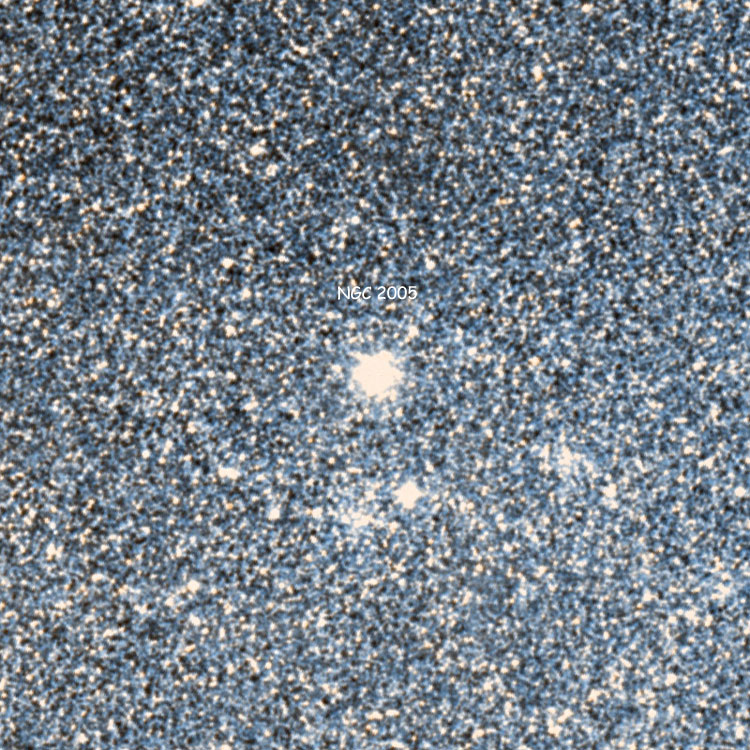
Above, a 12 arcmin wide DSS image centered on NGC 2005
Below, a 2 arcmin wide DSS image of the cluster
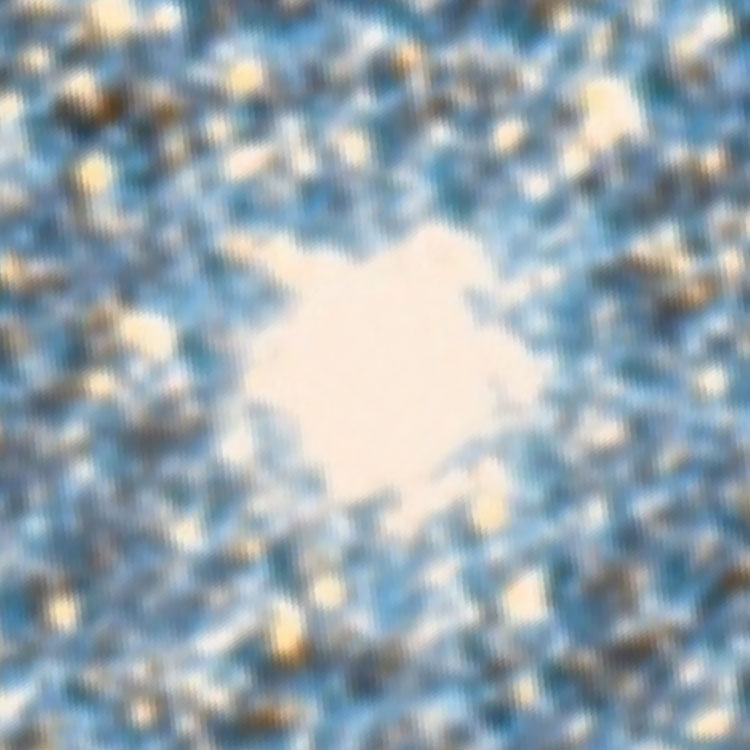
Below, a 0.3 arcmin wide HST image of the cluster (Image Credit Hubble Legacy Archive, Courtney Seligman)
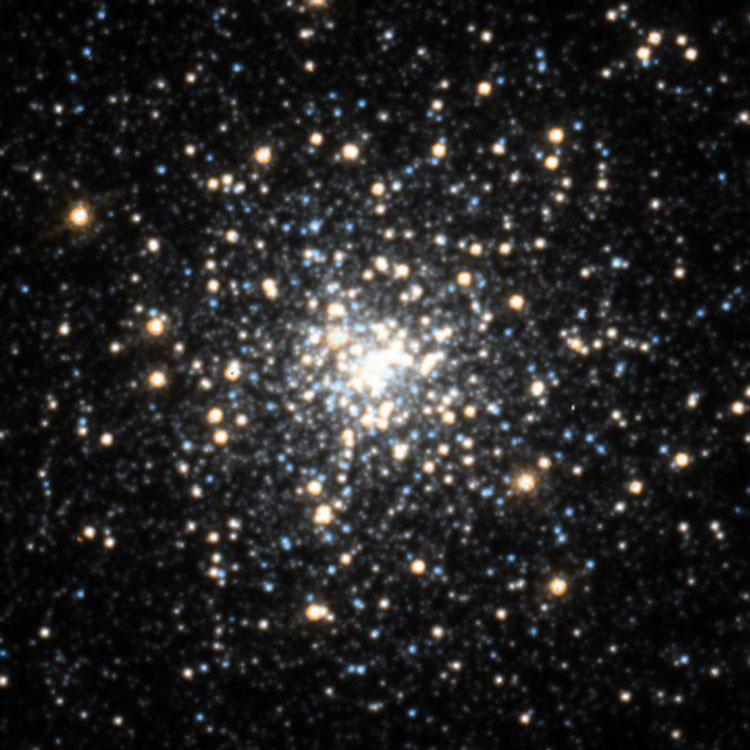
Below, a 1 degree wide DSS image showing the location of the cluster relative to the LMC

Below, a 2 degree wide DSS image showing the location of the cluster relative to the LMC

NGC 2006 (a pair of OCLs in the Large Magellanic Cloud)
(also known as ESO 086-008 (= SL537) + ESO 086-007 (= SL538))
Discovered (Dec 23, 1834) by John Herschel
A pair of open clusters in Dorado (RA 05 31 20.0, Dec -66 57 54)
SL 538 = "PGC 4590999" is a magnitude 11(?) open cluster at RA 05 31 19.6, Dec -66 57 29
SL 537 = "PGC 3518066" is a magnitude 11.0 open cluster at RA 05 31 20.0, Dec -66 58 21
Historical Identification: Per Dreyer, NGC 2006 (= GC 1209 = JH 2895, 1860 RA 05 31 27, NPD 157 04.1) is "a cluster, extremely large, very rich, very bright very small nucleus and middle". The position precesses to RA 05 31 19.4, Dec -66 58 16, which falls on the northern rim of the southern member of the pair of clusters listed above, but per the Discovery Note below, NGC 2006 should almost certainly be assigned to the pair, rather than only the southern cluster.
Discovery Note: NGC 2006 is often assigned only to the southern cluster, but in his two observations of the area Herschel measured two slightly different positions, each of which corresponds to one cluster or the other, and since both observations were assigned to a single GC and NGC entry, both clusters should be considered to be part of NGC 2006.
Note About PGC Designations: For purposes of completeness LEDA assigns a PGC designation to all NGC objects, even if they are not galaxies, and in this case assigns a different designation for each of the two clusters; but a search of the database for the PGC designations return no result, so they are shown in quotes. Instead, a search should be made for the ESO designations, which are therefore shown first.
Physical Information: The pair of clusters are located in the Large Magellanic Cloud, which is about 160 to 165 thousand light years away. Given that and the apparent sizes of about 1.05 arcmin for the southern cluster and about 0.85 arcmin for the northern cluster (both sizes from the images below), the southern cluster is about 50 light years across, and the northern cluster is about 40 light years across. The overall apparent size of the pair is about 1.95 by 1.2 arcmin (again, from the images below), so together they span about 90 to 95 light years. NGC 2006 is listed as part of Lucke-Hodge stellar association 77, along with NGC 2002, 2027 and 2034, and SL objects 538, 582 and 586..

Above, a 12 arcmin wide DSS image centered on NGC 2006, also showing NGC 2002
Below, a 2.75 arcmin wide DSS image of the pair of clusters comprising NGC 2006
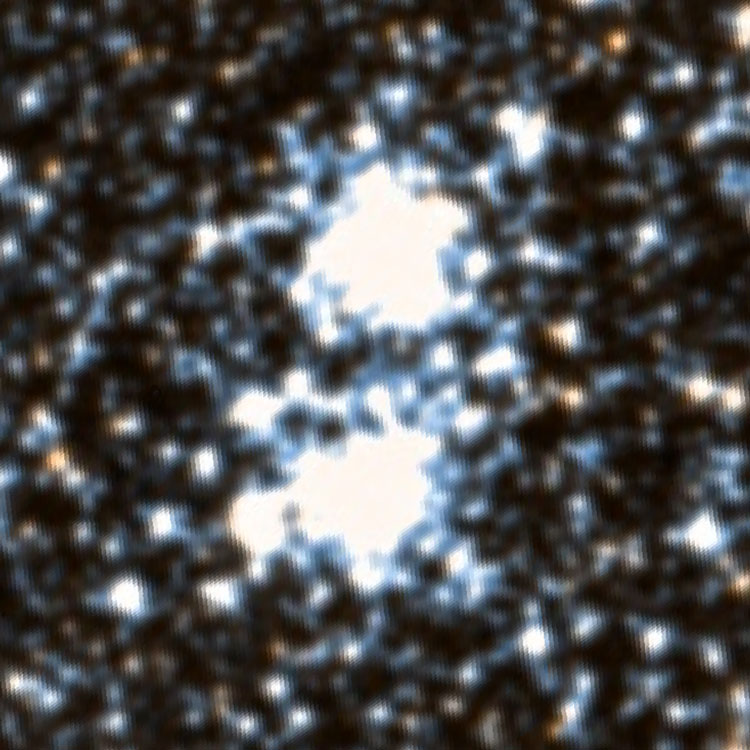
Below, a 1 degree wide DSS image showing the location of the cluster relative to the LMC
Also shown are NGC 2002, 2003 and 2004

Below, a 2 degree wide DSS image showing the location of the cluster relative to the LMC
Also shown are NGC 2002, 2003, 2004, 2011, 2014 and 2020
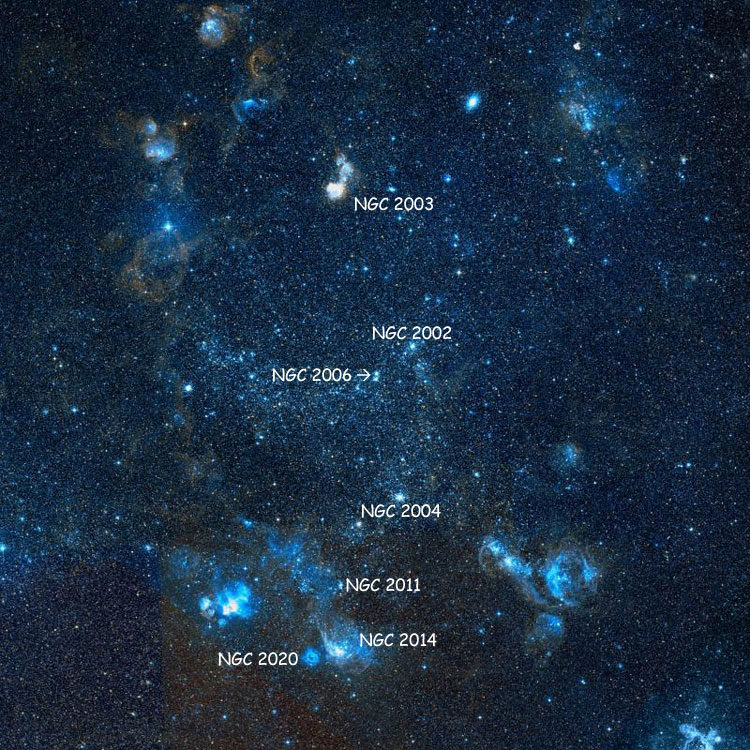
NGC 2007 (= PGC 17478 = ESO 204-019)
Discovered (Dec 27, 1834) by John Herschel
A magnitude 13.9(?) spiral galaxy (type SB(rs)c) in Pictor (RA 05 34 59.2, Dec -50 55 18)
Historical Identification: Per Dreyer, NGC 2007 (= GC 1210 = JH 2892, 1860 RA 05 31 37, NPD 141 01.2) is "extremely faint, pretty large, round". The position precessess to RA 05 34 58.0, Dec -50 55 46, less than 0.5 arcmin south southwest of the galaxy listed above, the description fits (keeping in mind the difference between visual and telescopic observations) and the only nearby object is obviously NGC 2008, which was observed in the same sweep by Herschel, so the identification is certain.
Physical Information: Based on a recessional velocity relative to the Cosmic Microwave Background of 4580 km/sec (and H0 = 70 km/sec/Mpc), NGC 2008 is about 210 to 215 million light years away, in reasonable agreement with redshift-independent distance estimates of about 145 to 200 million light years. Given that and its apparent size of about 1.8 by 0.45 arcmin (from the images below), the galaxy is about 110 to 115 thousand light years across.
Note About Apparent Brightness: Because it is much closer, NGC 2007 looks significantly larger and in some ways brighter than NGC 2008; but its central region is far fainter, and as a result its overall brightness is actually less. Exactly how much less is uncertain, as different references give different values for their brightness: Steinicke lists NGC 2007 as magnitude 13.4 and NGC 2008 as magnitude 13.2, NED lists NGC 2007 as magnitude 13.9 and NGC 2008 as magnitude 13.8, and LEDA lists NGC 2007 as magnitude 14.3 and NGC 2008 as magnitude 14.0, so the difference in magnitude ranges from 0.1 to 0.3 magnitudes, and the quoted magnitudes vary by nearly a magnitude, whence the question marks attached to the magnitudes shown in their initial descriptions.
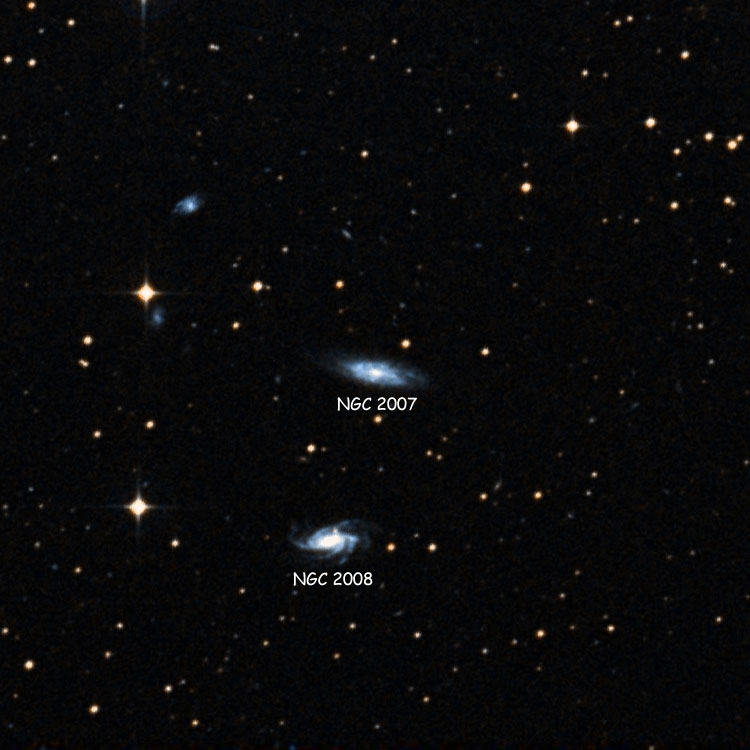
Above, a 12 arcmin wide DSS image centered on NGC 2007, also showing NGC 2008
Below, a 2.4 arcmin wide DSS image of the galaxy

Below, a 1.5 by 0.75 arcmin wide image of the western half of the galaxy (Image Credit Hubble Legacy Archive)
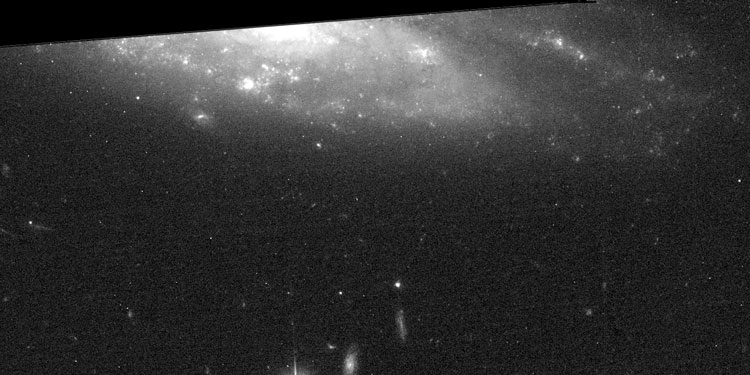
NGC 2008 (= PGC 17480 = ESO 204-020)
Discovered (Dec 27, 1834) by John Herschel
A magnitude 13.8(?) spiral galaxy (type SA(s)c) in Pictor (RA 05 35 03.8, Dec -50 58 01)
Historical Identification: Per Dreyer, NGC 2008 (= GC 1211 = JH 2894, 1860 RA 05 31 45, NPD 141 02.9) is "extremely faint, pretty large, round, a very little brighter middle". The position precesses to RA 05 35 05.7, Dec -50 57 29, less than 0.6 arcmin northeast of the galaxy listed above, the description fits and the only nearby object is obviously NGC 2007, which was observed in the same sweep by Herschel, so the identification is certain.
Physical Information: Based on a recessional velocity relative to the Cosmic Microwave Background of 10365 km/sec (and H0 = 70 km/sec/Mpc), a straightforward calculation indicates that NGC 2008 is about 480 to 485 million light years away, in good agreement with redshift-independent distance estimates of about 415 to 495 million light years (the HST press release used a distance of only 425 million light years). However, for objects at such distances we should take into account the expansion of the Universe during the time it took their light to reach us. Doing that shows that the galaxy was about 460 to 465 million light years away at the time the light by which we see it was emitted, about 470 to 475 million years ago (the difference between the two numbers being due to the expansion of the intervening space during the light-travel time). Given that and its apparent size of about 1.7 by 0.8 arcmin (from the images below), the galaxy is about 230 thousand light years across.
Note About Apparent Brightness: Because it is much closer, NGC 2007 looks significantly larger and in some ways brighter than NGC 2008; but its central region is far fainter, and as a result its overall brightness is actually less. Exactly how much less is uncertain, as different references give different values for their brightness: Steinicke lists NGC 2007 as magnitude 13.4 and NGC 2008 as magnitude 13.2, NED lists NGC 2007 as magnitude 13.9 and NGC 2008 as magnitude 13.8, and LEDA lists NGC 2007 as magnitude 14.3 and NGC 2008 as magnitude 14.0, so the difference in magnitude ranges from 0.1 to 0.3 magnitudes, and the quoted magnitudes vary by nearly a magnitude, whence the question marks attached to the magnitudes shown in their initial descriptions.

Above, a 12 arcmin wide DSS image centered on NGC 2008, also showing NGC 2007
Below, a 2.25 by 1.4 arcmin wide HST image of the galaxy

(Image Credit above and below ESA/Hubble & NASA, A. Bellini)
Below, a 1.1 by 2.25 arcmin wide image of the galaxy (north on right to show more detail)

NGC 2009 (an OCL in the Large Magellanic Cloud = "PGC 3518067")
(also known as ESO 056-SC140 and SL 534)
Discovered (Nov 3, 1834) by John Herschel
A magnitude 11.0 open cluster in Dorado (RA 05 30 59.9, Dec -69 10 55)
Historical Identification: Per Dreyer, NGC 2009 (= GC 1212 = JH 2897, 1860 RA 05 31 59, NPD 159 16.9) is "pretty faint, pretty small, round, gradually a little brighter middle, in a cluster". The position precesses to RA 05 30 59.6, Dec -69 11 05, right on the cluster listed above, the description fits ("in a cluster" presumably referring to the multitude of bright stars surrounding the cluster) and there is nothing comparable nearby, so the identification is certain.
Note About PGC Designation: For purposes of completeness LEDA assigns a PGC designation to all NGC objects, even if they are not galaxies, whence the designation shown in the title of this entry; but a search of the database for that designation returns no result, so it has been placed in quotes.
Physical Information: NGC 2009 is in the Large Magellanic Cloud, which is about 160 to 165 thousand light years away. Given that and its apparent size of about 1.0 by 0.8 arcmin (from the images below), the cluster is about 45 to 50 light years across.

Above, a 12 arcmin wide DSS image centered on NGC 2009, also showing part of NGC 2015
Below, a 1.75 arcmin wide DSS image of the cluster

Below, a 1 degree wide DSS image showing the location of the cluster relative to the LMC
Also shown is NGC 2015

Below, a 2 degree wide DSS image showing the location of the cluster relative to the LMC
Also shown is NGC 2015

NGC 2010 (an OCL in the Large Magellanic Cloud = "PGC 3518068")
(also known as ESO 056-SC319 and SL 531)
Discovered (Nov 12, 1836) by John Herschel
A magnitude 11.7 open cluster in Mensa (RA 05 30 33.9, Dec -70 49 01)
Historical Identification: Per Dreyer, NGC 2010 (= GC 1213 = JH 2898, 1860 RA 05 32 16, NPD 160 56.0) is "faint, considerably large, round, very gradually a little brighter middle". The position precesses to RA 05 30 30.5, Dec -70 50 10, about 1 arcmin south southwest of the cluster listed above, the description fits and there is nothing comparable nearby, so the identification is certain.
Note About PGC Designation: For purposes of completeness LEDA assigns a PGC designation to all NGC objects, even if they are not galaxies, whence the designation shown in the title of this entry; but a search of the database for that designation returns no result, so it has been placed in quotes.
Physical Information: NGC 2010 is in the Large Magellanic Cloud, which is about 160 to 165 thousand light years away. Given that and its apparent size of about 1.65 by 1.4 arcmin (from the images below), the cluster is about 75 to 80 light years across.
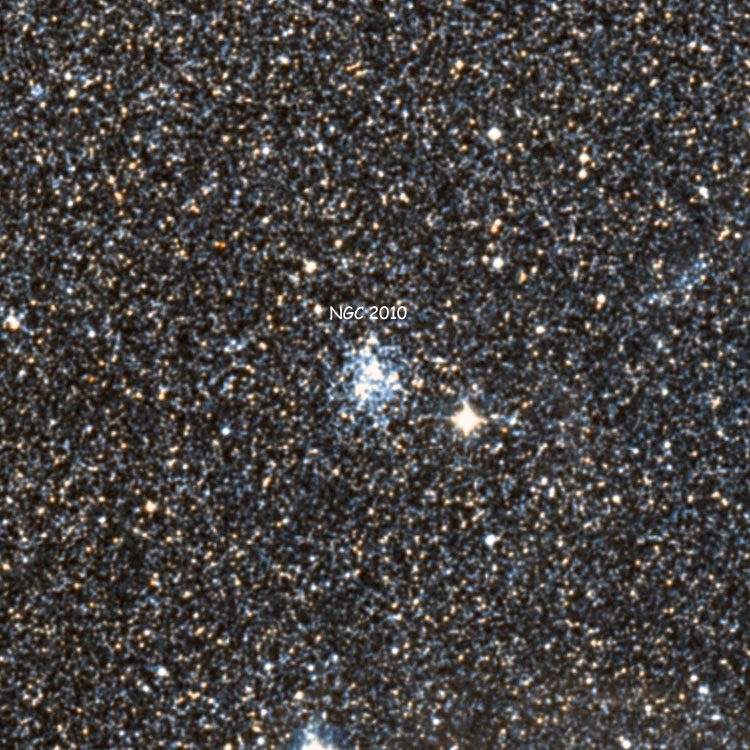
Above, a 12 arcmin wide DSS image centered on NGC 2010
Below, a 3 arcmin wide DSS image of the cluster
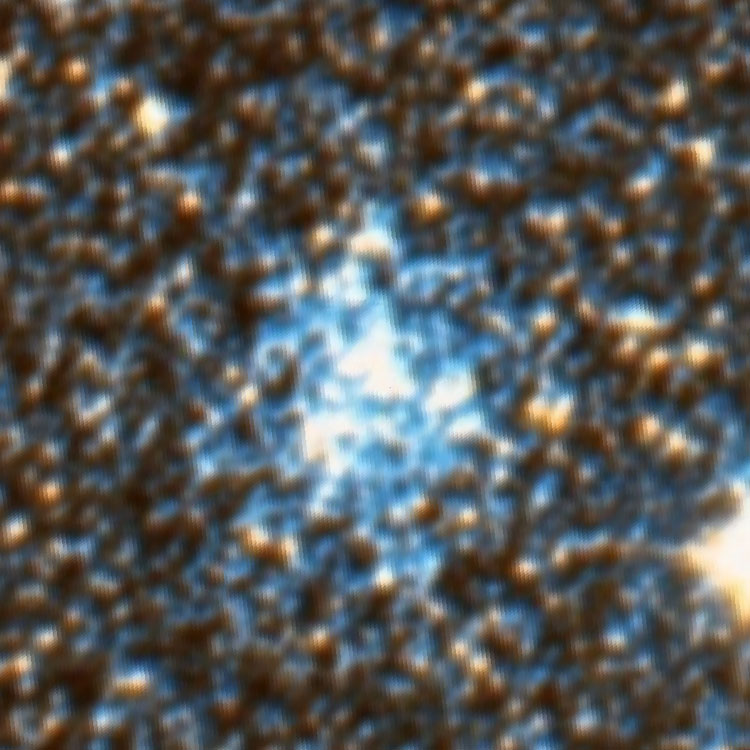
Below, a 1 degree wide DSS image showing the location of the cluster relative to the LMC
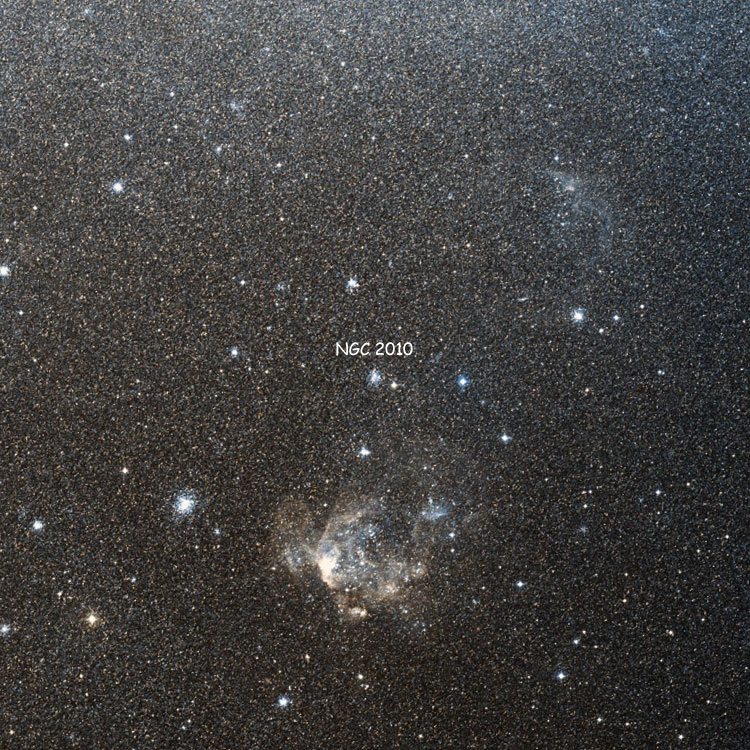
Below, a 2 degree wide DSS image showing the location of the cluster relative to the LMC
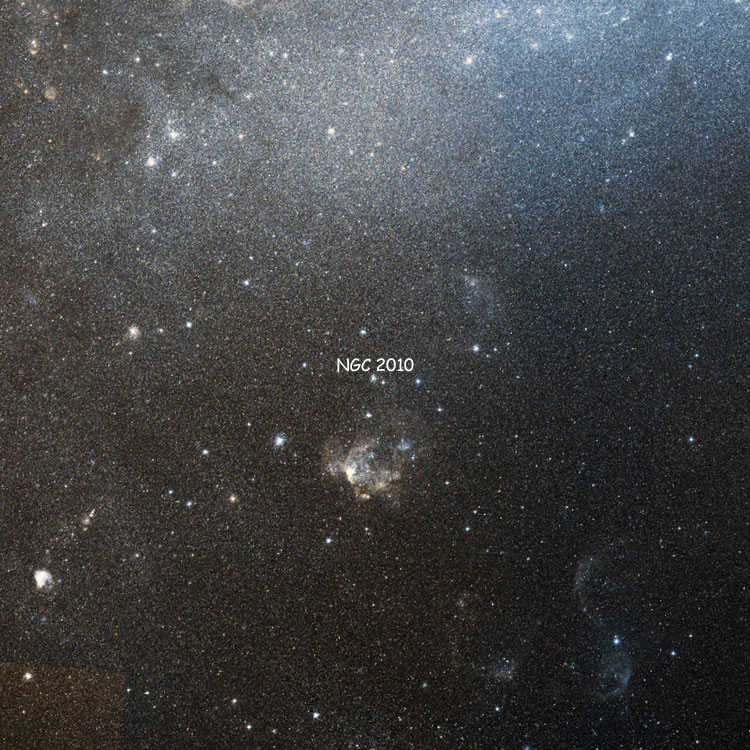
NGC 2011 (an OCL in the Large Magellanic Cloud = "PGC 3518069")
(also known as ESO 056-SC144, SL 559 and part of LH 75)
Discovered (1826) by James Dunlop
Discovered (Jan 31, 1835) by John Herschel
A magnitude 10.6 open cluster in Dorado (RA 05 32 19.8, Dec -67 31 17)
Historical Identification: Per Dreyer, NGC 2011 (= GC 1214 = JH 2899, (Dunlop 192), 1860 RA 05 32 41, NPD 157 37.0) is "very bright, small, round, pretty suddenly much brighter middle". The position precesses to RA 05 32 21.2, Dec -67 31 24, almost dead on the cluster listed above, the description fits and there is nothing comparable nearby, so the identification is certain.
Discovery Note: Steinicke now lists Dunlop as the discoverer, hence the addition of his name to Dreyer's entry in parentheses.
Note About PGC Designation: For purposes of completeness LEDA assigns a PGC designation to all NGC objects, even if they are not galaxies, whence the designation shown in the title of this entry; but a search of the database for that designation returns no result, so it has been placed in quotes.
Physical Information: NGC 2011 is in the Large Magellanic Cloud, which is about 160 to 165 thousand light years away. Given that and its apparent size of about 1.3 by 0.8 arcmin (from the images below), the cluster is about 60 to 65 light years across. NGC 2011 is listed as part of Lucke-Hodge stellar association 75, along with e56.

Above, a 12 arcmin wide DSS image centered on NGC 2011
Below, a 2.25 arcmin wide DSS image of the cluster

Below, a 0.8 by 0.9 arcmin wide image of the cluster (Image Credit Hubble Legacy Archive, Wikimedia Commons)

Below, a 1 degree wide DSS image showing the location of the cluster relative to the LMC
Also shown are NGC 2004, 2014 and 2020

Below, a 2 degree wide DSS image showing the location of the cluster relative to the LMC
Also shown are NGC 2002, 2004, 2006, 2014 and 2020
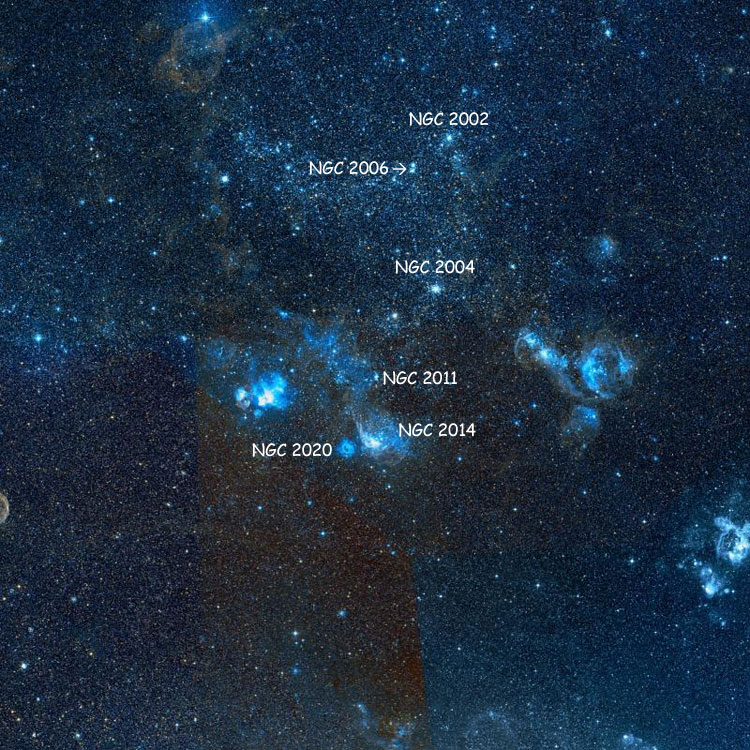
NGC 2012 (= PGC 17194 = ESO 016-005)
Discovered (Jan 22, 1836) by John Herschel
A magnitude 13.0 lenticular galaxy (type E/SA0?) in Mensa (RA 05 22 35.4, Dec -79 51 07)
Historical Identification: Per Dreyer, NGC 2012 (= GC 1215 = JH 2907, 1860 RA 05 32 42, NPD 169 57.4) is "very faint, small, a little extended, brighter middle, 2 stars 9 (arcmin) to northeast". The position precesses to RA 05 22 31.8, Dec -79 50 48, less than 0.4 arcmin northwest of the center of the galaxy listed above, the description fits (including the two stars to the northeast) and there is nothing else nearby, so the identification is certain.
Physical Information: Based on a recessional velocity relative to the Cosmic Microwave Background of 4910 km/sec (and H0 = 70 km/sec/Mpc), NGC 2012 is about 225 to 230 million light years away, in reasonable agreement with redshift-independent distance estimates of about 220 to 255 million light years. Given that and its apparent size of about 1.2 by 0.5 arcmin (from the images below), it is about 80 thousand light years across.

Above, a 12 arcmin wide DSS image centered on NGC 2012
Below, a 1.5 arcmin wide DSS image of the galaxy
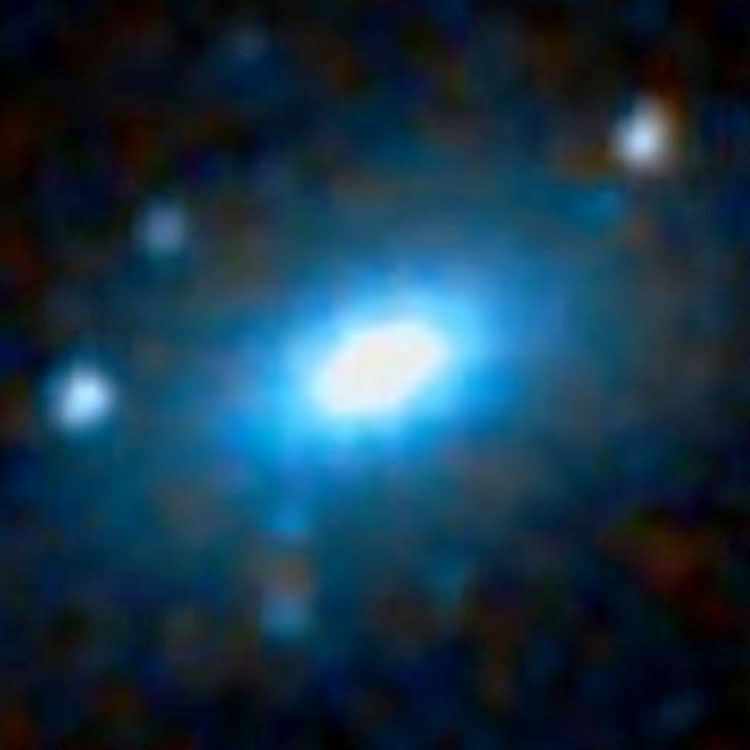
NGC 2013 (= "PGC 3518070")
Discovered (Feb 10, 1831) by John Herschel
Also observed (Oct 25, 1863) by Heinrich d'Arrest
A scattering of stars in Auriga (RA 05 44 23.0, Dec +55 46 48)
Historical Identification: NGC 2013 (= GC 1216 = JH 364, 1860 RA 05 32 43, NPD 34 16.8) is "a cluster, very little rich, stars of 11th magnitude". The position precesses to RA 05 44 26.9, Dec +55 47 34, well within the region occupied by the scattering of stars listed above, so although that scattering is not particularly impressive, and exactly how large it is is a matter of some debate, it is reasonably certain that it is what Herschel observed.
Note About d'Arrest's Observation: In his 1877 Supplement to Herschel's General Catalogue, Dreyer notes that in that work the NPD is incorrect (namely, 24 instead of 34 degrees), as a result of a misprint. It is quite likely that Dreyer noticed this by comparing the GC to Herschel's original paper of 1833, since he does not refer to d'Arrest's observation; but d'Arrest also noted that the position in the GC was wrong, so I have included his observation as a separate confirmation of that fact.
Discovery Note: Herschel's description was "A poor cluster of 8 or 10 stars of 11th magnitude". Gottlieb states that it probably consists of the two small groups spanning about 4 arcmin that are closest to the NGC position, but may include a third group to the northwest of those, in which case it would span about 7 arcmin. Corwin suggests that it may also include two stars south of the other groups, and span about 11 by 6.5 arcmin. The position I have chosen for this entry (and the image below) is within the quadrilateral formed by the central member of the three groups noted by Gottlieb.
Note About PGC Designation: For purposes of completeness LEDA assigns a PGC designation to almost all NGC objects, even if they are not galaxies, whence the designation shown in the title of this entry; but a search of the database for that designation returns no result, so it has been placed in quotes.
Physical Information: There is no evidence that the stars in this region are a physical cluster, and barring future studies of their radial velocities and proper motions there is no reason to think that they reresent anything other than a random alignment of field stars.

Above, a 12 arcmin wide DSS image centered on NGC 2013
All three of Gottlieb's "groups" are shown, and the two extra stars noted by Corwin
NGC 2014 (an OCL and EN in the Large Magellanic Cloud = "PGC 3518071")
(also known as LMC-N57A, ESO 056-SC146, SL 560 and part of LH 76)
Possibly discovered (Aug 3, 1826) by James Dunlop
Discovered (Nov 23, 1834) by John Herschel
A magnitude 9.0 open cluster and emission nebula in Dorado (RA 05 32 19.0, Dec -67 41 24)
Historical Identification: Per Dreyer, NGC 2014 (= GC 1217 = JH 2900, (Dunlop 217?), 1860 RA 05 32 48, NPD 157 47.4) is "a cluster, pretty large, pretty compressed, irregular figure, stars from 9th to 15th magnitude". The position precesses to RA 05 32 24.3, Dec -67 41 49, which is the location of the brightest stars in the cluster and the description fits, so the identification is certain.
Discovery Note: Dunlop's observation was not identified until recently, hence its addition to Dreyer's entry in parentheses. Steinicke lists this as Dunlop 217 and 218. However, Dunlop's description is of a much smaller object, and is more likely to be NGC 2020. Herschel's notes say nothing of the (in photographic images) spectacular emission nebula (LMC-N57A) lit up by the cluster, so NGC 2014 probably should be treated as only the cluster; but per Gottlieb, the brightest part of the nebula is faintly visible with a 30-inch telescope, and in any case long tradition considers it to be part of the NGC object, so it is also treated as such here.
Note About PGC Designation: For purposes of completeness LEDA assigns a PGC designation to almost all NGC objects, even if they are not galaxies, whence the designation shown in the title of this entry; but a search of the database for that designation returns no result, so it has been placed in quotes.
Physical Information: The cluster is in the Large Magellanic Cloud, which is about 160 to 165 thousand light years across, so its apparent size of about 5.5 by 5 arcmin (from the images below) means that it spans about 260 light years, and there is a wide scattering of stars over an even larger region. The emission nebula lit up by the cluster has an apparent size of about 11 by 7.7 arcmin (also from the images below), so it spans about 520 to 530 light years. NGC 2014 is listed as part of Lucke-Hodge stellar association 76, along with e56 and e57. The red color of the emission nebula is due to radiation by hydrogen gas excited by ultraviolet radiation from the stars in the cluster. This is the most common cause of emission nebula radiation, and is a striking contrast to the bluish color of NGC 2020, which see.

Above, a 15 arcmin wide DSS image centered north of NGC 2014, also showing NGC 2011 and 2020
Below, a 12 arcmin wide DSS image of the cluster and associated emission nebula, also showing NGC 2020
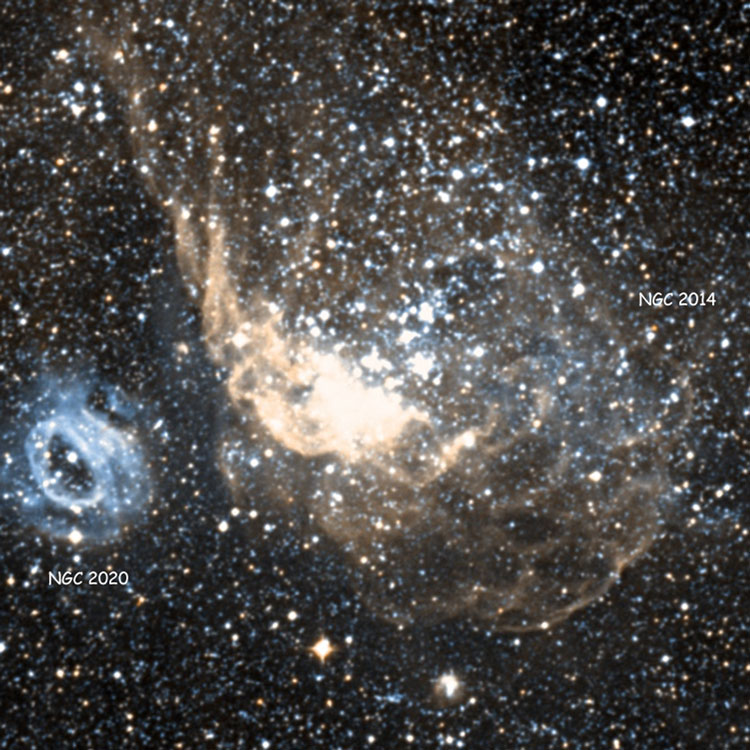
Below, a 0.4 by 0.7 arcmin wide image of NGC 2014 (Image Credit ESO)

Below, a 0.7 arcmin wide image of the NGC 2014, also showing NGC 2020 (Image Credit ESO)

Below, a 1 arcmin wide DSS image showing the position of NGC 2014 relative to the LMC
Also shown are NGC 2004, 2011 and 2020

Below, a 2 arcmin wide DSS image showing the position of NGC 2014 relative to the LMC
Also shown are NGC 2002, 2004, 2006, 2011 and 2020

NGC 2015 (a star cloud and OCL in the Large Magellanic Cloud = "PGC 3518071")
(OCL also known as ESO 056-SC147, SL 557 and part of LH 74)
Discovered (Nov 24, 1834) by John Herschel
A star cloud in Dorado (RA 05 31 35.0, Dec -69 14 10)
SL 557 = A magnitude 11.6 open cluster at RA 05 32 6.5, Dec -69 14 30
Historical Identification: Per Dreyer, NGC 2015 (= GC 1218 = JH 2901, 1860 RA 05 32 52, NPD 159 21.3) is "a cluster, very large, rich, very little compressed". The position precesses to RA 05 31 50.4, Dec -69 15 40, within the southeastern outline of the star cloud listed above, which as noted by Corwin is most obvious in images of a field about half a degree across.
Identification Notes: Although sometimes identified as only the open cluster SL 557, NGC 2015 is a star cloud comprising most of LH 74, reaching NGC 2009 on the northwest and SL 557 on the east.
Note About PGC Designation: For purposes of completeness LEDA assigns a PGC designation to almost all NGC objects, even if they are not galaxies, whence the designation shown in the title of this entry; but a search of the database for that designation returns no result, so it has been placed in quotes.
Physical Information: NGC 2015 is located in the Large Magellanic Cloud, which is about 160 to 165 thousand lives away. Given that and its apparent size of about 8 arcmin (from the images below), it is about 380 light years across. The open cluster SL 557 sometimes misidentified as NGC 2015 has an apparent size of about 0.7 by 0.65 arcmin (again from the images below), and is about 30 to 35 light years across. NGC 2015 is listed as part of Lucke-Hodge stellar association 74, along with e135.
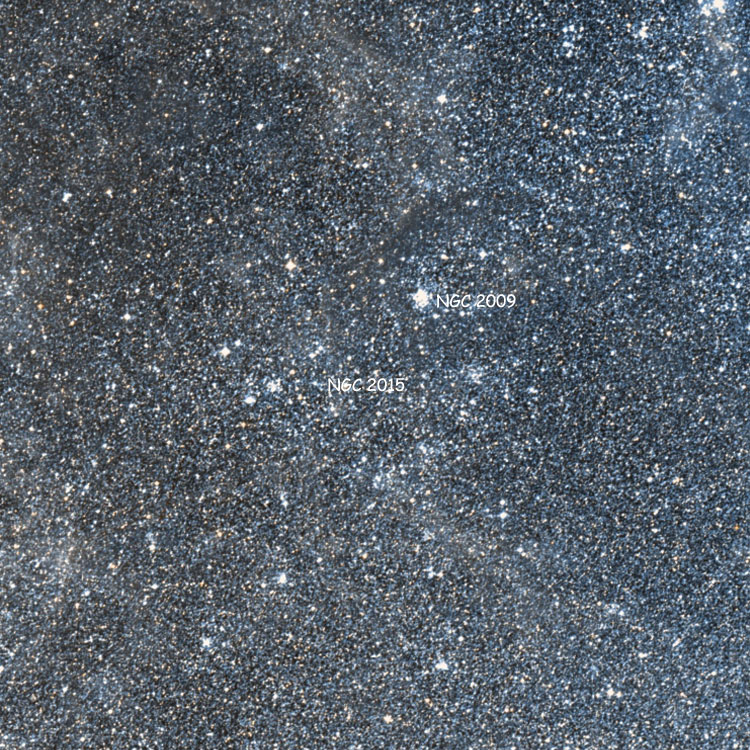
Above, a 30 arcmin wide DSS image centered on NGC 2015, also showing NGC 2009
Below, a 15 arcmin wide DSS image of the star cloud, also showing NGC 2009 and SL 557

Below, a 2.4 arcmin wide DSS image of SL 557, which is sometimes misidentified as NGC 2015
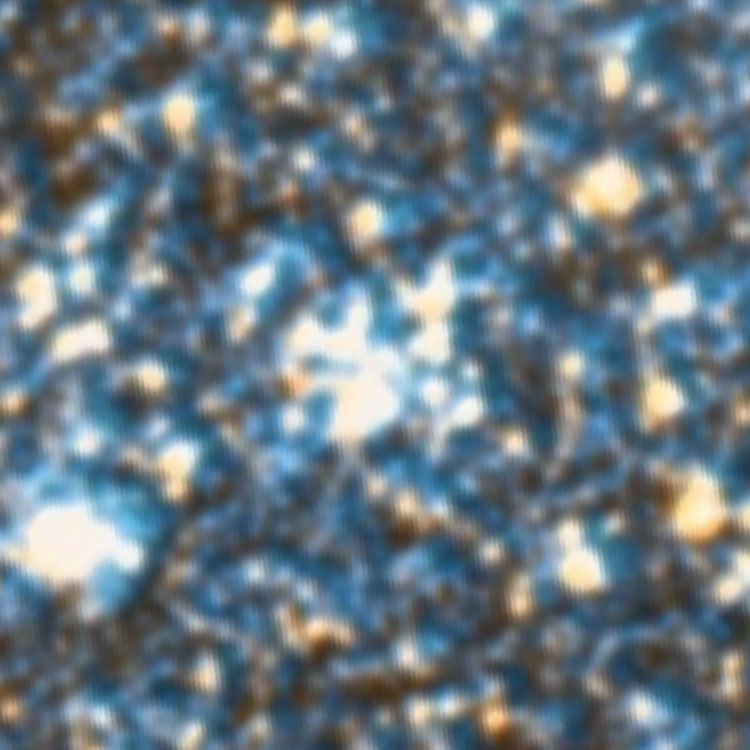
Below, a 1 degree wide DSS image showing the location of the star cloud relative to the LMC
Also shown is NGC 2009
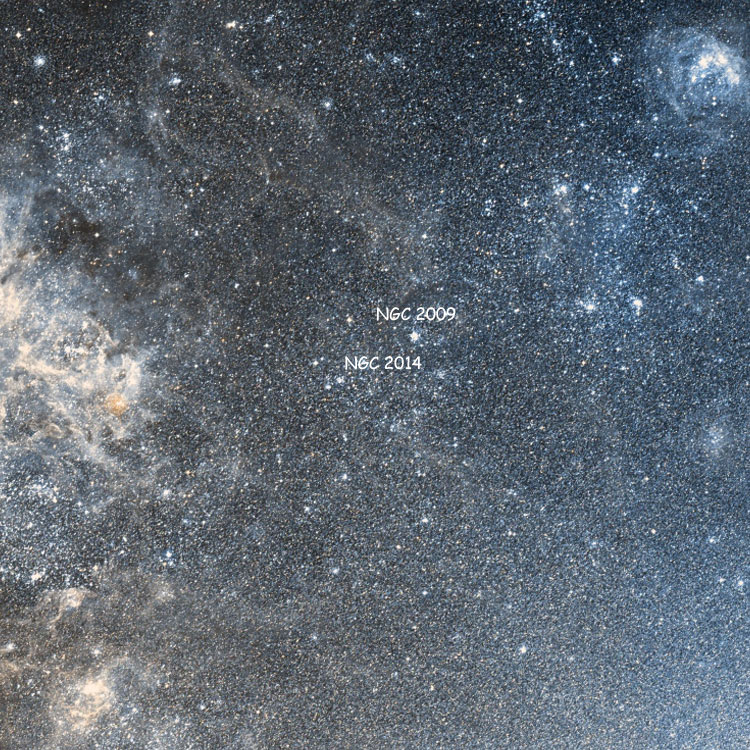
Below, a 2 degree wide DSS image showing the location of the star cloud relative to the LMC
Also shown is NGC 2009

WORKING HERE
NGC 2016 (an OCL in the Large Magellanic Cloud = "PGC 3518073")
(also known as ESO 056-142 and SL 547)
Discovered (Dec 23, 1834) by John Herschel
A magnitude 10.4 open cluster in Mensa (RA 05 31 38.8, Dec -69 56 50)
Historical Identification: Per Dreyer, NGC 2016 (= GC 1219 = JH 2902, 1860 RA 05 32 58, NPD 160 03.1) is "faint, very large, irregularly round, gradually brighter middle". The position precesses to RA 05 31 37.7, Dec -69 57 27, just south of the outline of the cluster listed above, and save for the fact that it is hard to see in DSS images because the surrounding starfield is so densely packed, the identification is certain.
Note About PGC Designation: For purposes of completeness LEDA assigns a PGC designation to almost all NGC objects, even if they are not galaxies, whence the designation shown in the title of this entry; but a search of the database for that designation returns no result, so it has been placed in quotes.
Physical Information: NGC 2016 is in the Large Magellanic Cloud, which is about 160 to 165 thousand light years away. Given that and its apparent size of about 1.8 arcmin (from the images below and Steve Gottlieb's observations), it is about 85 light years across. It is, as noted above, hard to distinguish from its starry background, particularly in closeup images; but is obvious in wider-field views (such as the 1 degree image below).

Above, a 12 arcmin wide DSS image centered on NGC 2016
Below, a 4 arcmin wide DSS image of the cluster=

Below, a 1 degree wide DSS image showing the location of the cluster relative to the LMC
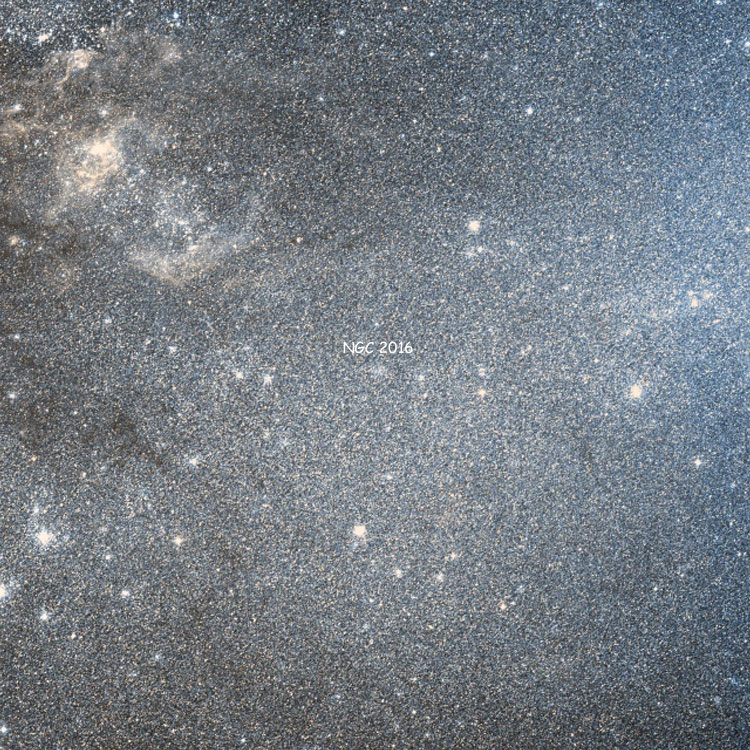
Below, a 2 degree wide DSS image showing the location of the cluster relative to the LMC
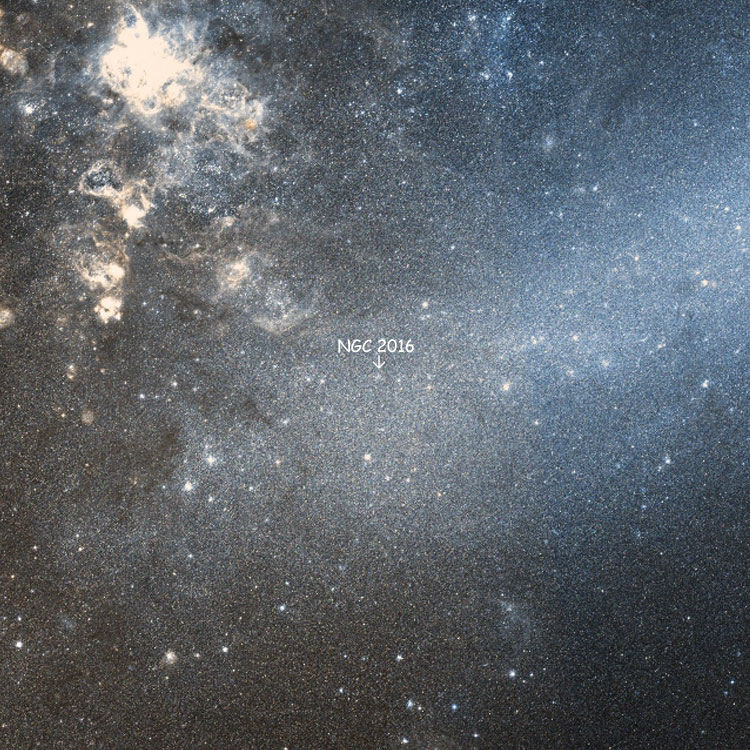
NGC 2017 (= "PGC 2958682")
Discovered (Dec 11, 1835) by John Herschel
A magnitude 6(?) group of stars in Lepus (RA 05 39 17.3, Dec -17 50 42)
Historical Identification: Per Dreyer, NGC 2017 (= GC 1220 = JH 2896, 1860 RA 05 33 08, NPD 107 55.8) is "a cluster of large (bright) stars". The position precesses to RA 05 39 18.2, Dec -17 50 57, just east of the brightest star in the cluster listed above and there is nothing comparable nearby, so the identification is certain.
Note About PGC Designation: For purposes of completeness LEDA assigns a PGC designation to almost all NGC objects, even if they are not galaxies, whence the designation shown in the title of this entry; but a search of the database for that designation returns no result, so it has been placed in quotes.
Physical Information: NGC 2017 is a group of four bright stars (the brightest being 6.4 magnitude HD 37643) and three fainter ones which form an apparent cluster; but their proper motions are randomly oriented, and one of them has a proper motion over twenty times larger than any of the others, so the group is almost certainly merely an accidental asterism. However, it is a striking sight in a small telescope, and well worth observing. The apparent size of the group is about 3.7 by 1.8 arcmin (from the image below), but since this is not an actual cluster, it has no corresponding physical size.
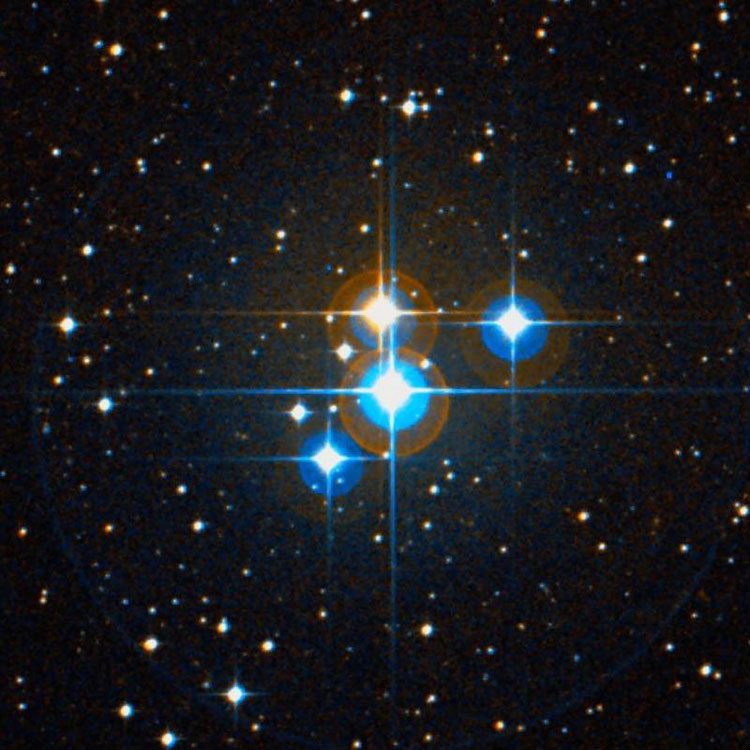
Above, a 12 arcmin wide DSS image centered on NGC 2017
NGC 2018 (an OCL and EN in the Large Magellanic Cloud = "PGC 3518074")
(also known as ESO 056-141, SL 533, LMC N206A and part of LH 69)
Discovered (Nov 3, 1834) by John Herschel
A magnitude 10.2 open cluster and emission nebula in Mensa (RA 05 31 23.7, Dec -71 04 13)
Historical Identification: Per Dreyer, NGC 2018 (= GC 1221 = JH 2904, 1860 RA 05 33 17, NPD 161 10.3) is "pretty bright, pretty large, round, pretty gradually a little brighter middle, 10th magnitude star involved on west" (star position per Corwin RA 05 31 15.7, Dec -71 04 10). The NGC position precesses to RA 05 31 23.9, Dec -71 04 40, on the southern rim of the brightest region discussed in the Observational Note below, and the NGC description fits the cluster and nebulosity listed above perfectly, so the identification is certain.
Note About PGC Designation: For purposes of completeness LEDA assigns a PGC designation to almost all NGC objects, even if they are not galaxies, whence the designation shown in the title of this entry; but a search of the database for that designation returns no result, so it has been placed in quotes.
Physical Information: NGC 2018 is the brightest part of a large region of bright stars, star clusters and nebulosity in the Large Magellanic Cloud. The ESO designation corresponds to the entire region, which is about 8 arcmin across, but NGC 2018 is the small cluster and surrounding nebulosity on the eastern side of that region, and this entry is primarily concerned only with that (the Observational Note below, excerpted from Steve Gottlieb's site, discusses the whole region). Since the Large Magellanic Cloud is about 160 to 165 thousand light years away, the apparent size of NGC 2018's open cluster of about 1.5 arcmin (from the images below) implies that it is about 70 light years across, while the about 2.5 by 1.5 arcmin spanned by the nebulosity (also from the images below) corresponds to about 115 to 120 light years. NGC 2018 is listed as part of Lucke-Hodge stellar association 69, along with e206.
Note About The Nebulosity: Per the Anglo-American Observatory discussion of their image of NGC 2018 (among those shown below), the brightest part of the nebulosity in their image is a supernova remnant, probably caused by the explosion of one of the stars in the open cluster, which contains many young, hot bright stars which don't take long (on an astronomical time scale) to live out their lives and go supernova. This conclusion is based on the green regions seen in that image, which represent radiation by O III (doubly ionized oxygen) ions. Such radiation is a hallmark of most supernova remnants.
Observational Note (comments by Steve Gottlieb): "This is a fascinating showpiece HII complex with a cluster (SL 533) and a large, detailed nebula (N206)... the cluster is about 8 arcmin in diameter and includes a couple of dozen magnitude 11 - 15 stars (part of the stellar association LH 69)..."
"The brightest region of nebulosity (NGC 2018 = LMC-N206A) is a very prominent 1 arcmin circular patch on the east end of the cluster. Fainter wings extend north and south, increasing the size to 3 by 1 arcmin. A wide pair of stars including magnitude 11.5 HDE 269676 [a massive, compact cluster containing several O-type stars] is at the west edge of this patch. Three additional elongated patches (each 1 to 1.5 arcmin in diameter) along the southwestern side of the complex are strung out in a 6 arcmin long line oriented northwest to southeast... Another glowing patch of nebulosity, about 45 arcsec diameter, is to the west of the brightest region and surrounds a couple of brighter stars. Finally there is an isolated, elongated patch on the northwest end of the complex... that seems detached. Weaker sections of the nebulosity give the impression of dark lanes. Surprisingly, Herschel's description applies only to the brightests region at the east end of this entire complex." (The last sentence of Gottlieb's comments is equivalent to my opening statement in Physical Information.)
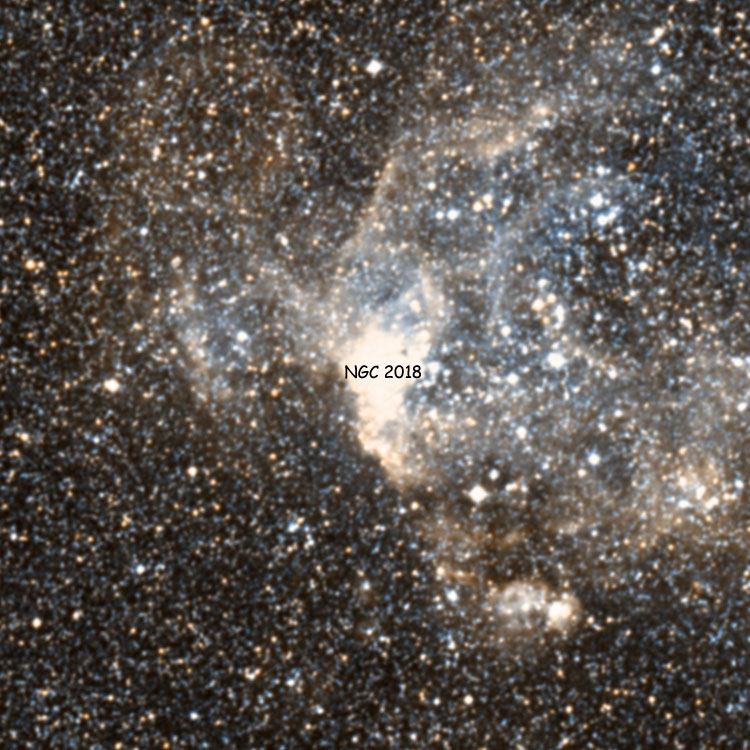
Above, a 12 arcmin wide DSS image centered on NGC 2018
Below, a 15 arcmin wide DSS image centered on the region discussed by Steve Gottlieb

Below, a 15 arcmin wide NOAO image of the region above (Image Credit NOAO)

Below, a 3.5 arcmin wide DSS image of NGC 2018
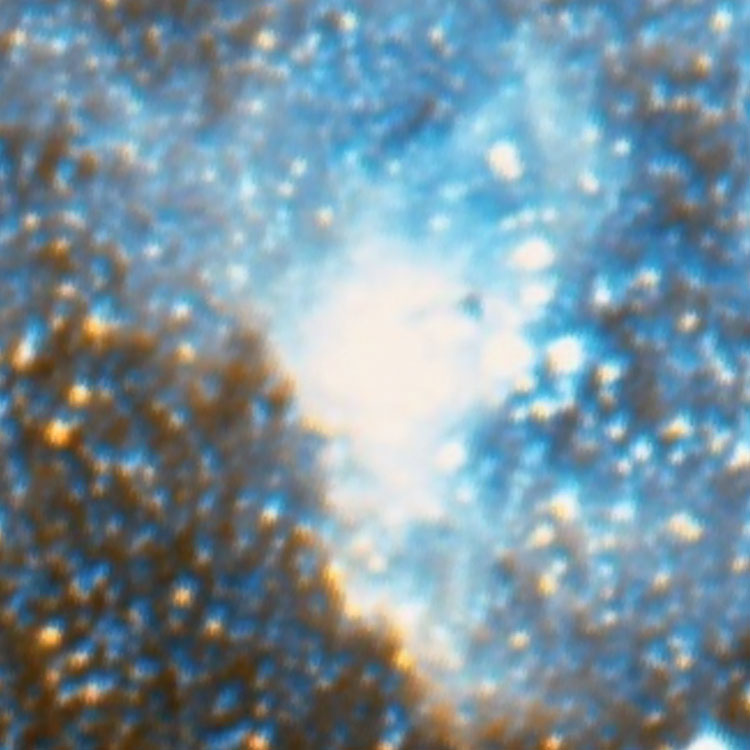
Below, a 3.5 arcmin wide NOAO image of NGC 2018 (Image Credit NOAO)

Below, a ? arcmin wide image of NGC 2018 (Image Credit uncertain; permission to use requested)

Below, a 1 degree wide DSS image showing the location of the cluster relative to the LMC

Below, a 2 degree wide DSS image showing the location of the cluster relative to the LMC

NGC 2019 (a GCL in the Large Magellanic Cloud)
Discovered (Sep 24, 1826) by James Dunlop
Also observed (Nov 11, 1836) by John Herschel
A magnitude 10.9 globular cluster in Mensa (RA 05 31 56.4, Dec -70 09 34)
Historical Identification: Per Dreyer, NGC 2019 (= GC 1222 = JH 2905, Dunlop 98, 1860 RA 05 33 29, NPD 160 15.1) is "bright, pretty large, gradually brighter middle".
Discovery Note: Steinicke lists this as Dunlop 99 instead of Dunlop 98.
Physical Information: In the Large Magellanic Cloud. Apparent size 1 arcmin.
NGC 2020 (an EN in the Large Magellanic Cloud)
Possibly observed (1826) by James Dunlop
Discovered (Dec 30, 1836) by John Herschel
An emission nebula in Dorado (RA 05 33 10.0, Dec -67 42 54)
Historical Identification: Per Dreyer, NGC 2020 (= GC 1223 = JH 2903, Dunlop 218, 1860 RA 05 33 31, NPD 157 48.3) is "faint, very large, very little extended, very gradually a little brighter middle".
Discovery Note: Steinicke does not list this as a Dunlop object.
Physical Information: Usually, the radiation from emission nebulae is reddish, since hydrogen gas is the most common material in interstellar clouds, and glows red when excited by the light from nearby stars; but NGC 2020 glows blue, due to an unusually large amount of oxygen atoms, and the extremely energetic radiation of the hot bright star near the center of the nebula, which is not only lighting up the gas but has also carved out a large hole in the surrounding gas, presumably by means of strong stellar winds associated with its formation. The blue color of NGC 2020 makes a striking contrast with the more normally colored NGC 2014, which see. Apparent size 2.0 arcmin.
NGC 2021 (an OCL in the Large Magellanic Cloud)
Discovered (Jan 31, 1835) by John Herschel
A magnitude 12.1 open cluster in Dorado (RA 05 33 30.6, Dec -67 27 15)
Historical Identification: Per Dreyer, NGC 2021 (= GC 1224 = JH 2906, NPD 05 33 47, NPD 157 33.0) is "very faint, small, round, in pretty large cluster".
Physical Information: NGC 2021 is listed as part of Lucke-Hodge stellar association 79, along with e56. In the Large Magellanic Cloud. Apparent size 0.9 arcmin.
NGC 2022 (= P-K 196-10.1 = "PGC 3517752")
Discovered (Dec 28, 1785) by William Herschel
Also observed (Jan 8, 1828) by John Herschel
A magnitude 11.6 planetary nebula in Orion (RA 05 42 06.2, Dec +09 05 11)
Historical Identification: Per Dreyer, NGC 2022 (= GC 1225 = JH 365 = WH IV 34, 1860 RA 05 34 26, NPD 80 59.3) is "a planetary nebula, pretty bright, very small, very little extended". The position precesses to RA 05 42 05.9, Dec +09 05 08, right on the nebula listed above, the description fits and there is nothing else nearby, so the identification is certain.
Note About PGC Designation: For purposes of completeness, LEDA assigns a PGC designation to NGC 2022, but since it is a planetary nebula a search of the database for that designation returns no result; hence its being in quotes.
Physical Information: Planetary nebulae represent gas blown away from a red giant before it collapses to a white dwarf. In the case of NGC 2022, a faint outer halo, a brighter inner halo, and the bright central nebula indicate at least three episodes of gas expulsion prior to the star's final collapse. All parts of the planetary nebula are (as shown in the following discussion) very small, so the final expulsion of gas and collapse of the star must have been relatively recent, compared to other planetary nebulae. Based on a SIMBAD parallax of 0.005312 arcsec, the nebula is about 615 light years away. The central nebula has an apparent size of about 0.35 by 0.3 arcmin, and its bright halo (best shown in the HST image) is about 0.6 by 0.5 arcmin across, but it is surrounded by a faint apparently circular halo about 1.45 arcmin across, with a slightly ragged even fainter extension about 1.75 arcmin across (all sizes from the images below). Given that and its presumed distance, the central nebula is only about 0.065 light years across, its bright halo is about 0.1 light years across, the brighter outer halo is about 0.25 light years in diameter, and its ragged extension is about 0.3 light years across. (Note: LEDA is the source of the magnitude listed above; SIMBAD lists the apparent magnitude as only 14.2, but that seems too faint given the brightness of the obviously overexposed DSS image of the central part of the nebula.)
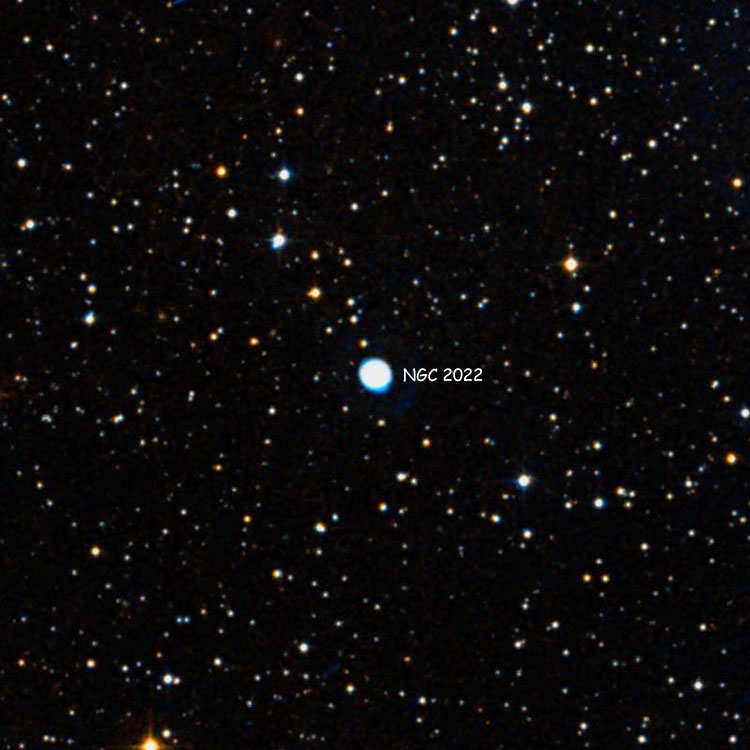
Above, a 12 arcmin wide DSS image centered on NGC 2022 (see note for PanSTARRS image)
Below, a 2 arcmin wide PanSTARRS image of the nebula (only the central nebula and halo are visible)
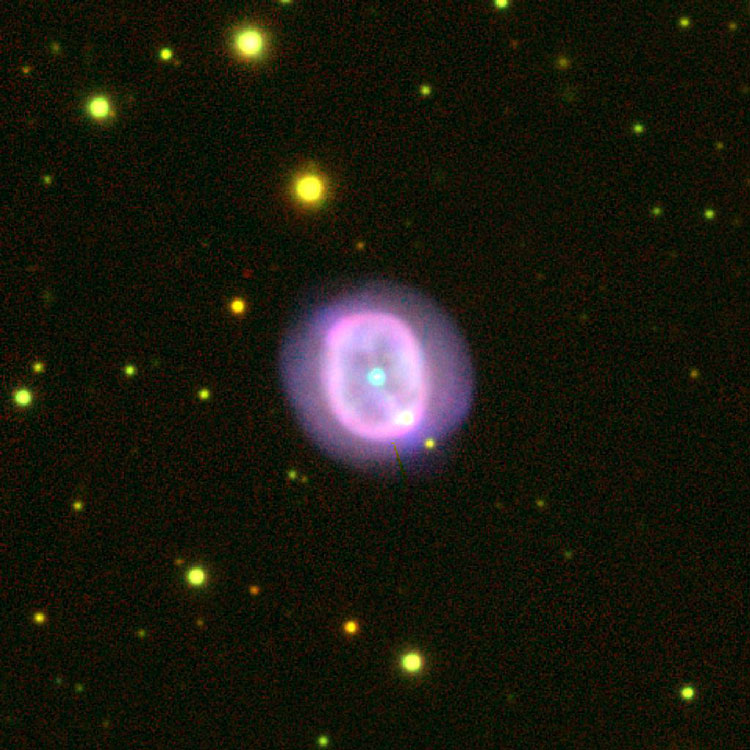
Below, the image above overlaid by a view of the nebula's outer halo
(Overylay Image Credit Corradi, Schönberner, Steffen & Perinotto; Planetary Nebula Image Catalogue)

Below, a 0.7 arcmin wide HST image of the central nebula (Image Credit ESA/Hubble & NASA, R. Wade)
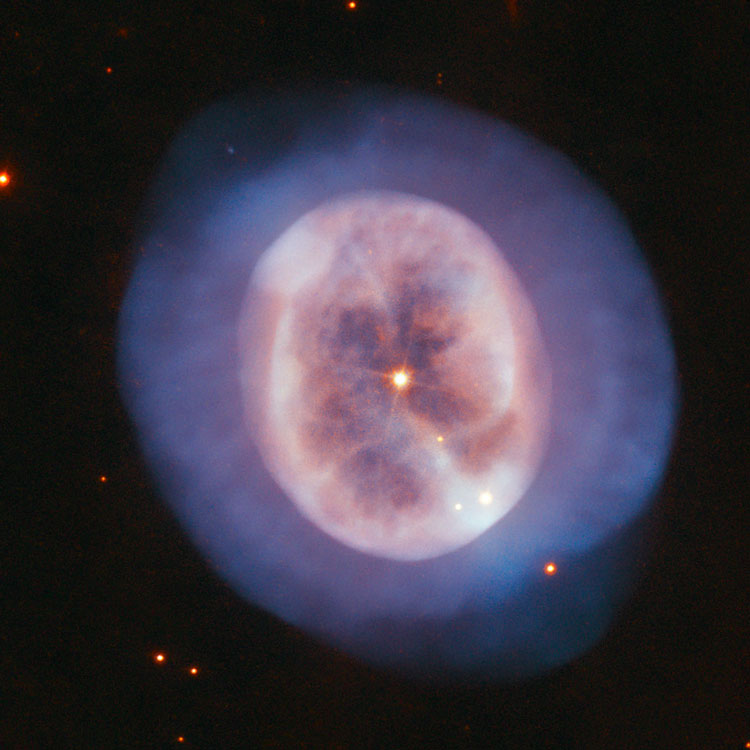
NGC 2023
Discovered (Jan 6, 1785) by William Herschel
An emission and reflection nebula in Orion (RA 05 41 38.4, Dec -02 15 32)
Historical Identification: Per Dreyer, NGC 2023 (= GC 1226 = WH IV 24, 1860 RA 05 34 36, NPD 92 18.7) is "a bright star in middle of large, little extended nebula".
Physical Information: Apparent size 10 by 10 arcmin.
NGC 2024, The Flame Nebula
Discovered (Jan 1, 1786) by William Herschel
Also observed (May? 1850) by Theodor Brorsen
An emission nebula in Orion (RA 05 41 43.0, Dec -01 51 24)
Historical Identification: Per Dreyer, NGC 2024 (= GC 1227 = WH V 28, 1860 RA 05 34 47, NPD 91 55.7) is "a remarkable object, irregular, bright, very very large, black spaces included".
Physical Information: Apparent size 30 by 30 arcmin. The "Flame" nebula, near the bright star Alnitak on the eastern side of the "belt" of Orion, in visible light (top image, below) and infrared (bottom image). Although the apparent closeness of Alnitak to the nebula suggests that its radiation is what lights up the nebula (Alnitak is a hundred thousand times brighter than the Sun, and two thirds of its "light" is ultraviolet radiation that is far more capable than visible light of causing such nebulae to glow), it is actually a foreground object, being only about 800 light years away, while the nebula is about 1500 light years distant. The actual energy source for the nebula is a group of OB stars hidden within its interior in visible light images, which have formed very recently (and in fact other such stars are probably forming within the nebula at the present time, as there is evidence that stars closer to the center of the nebula formed later than those in its outer regions). Another familiar feature, the Horsehead Nebula, is visible at bottom right. In the top image the Horsehead stands out as a dark feature silhouetted against the brightly glowing clouds behind it, while the Flame is substantially obscured by dark clouds in front of it. But in the bottom image infrared radiation penetrates the dust, showing the Flame in its full glory, while the Horsehead becomes barely noticeable without the background of visible-light radiation that usually highlights its its silhouette.

Above, a visible-light image of NGC 2024 (Credits Ryan Steinberg and Family/Adam Block/AURA/NSF/NOAO)
Below, an infrared image of the region (Credit J. Emerson/VISTA/Cambridge Astronomical Survey Unit, ESO)
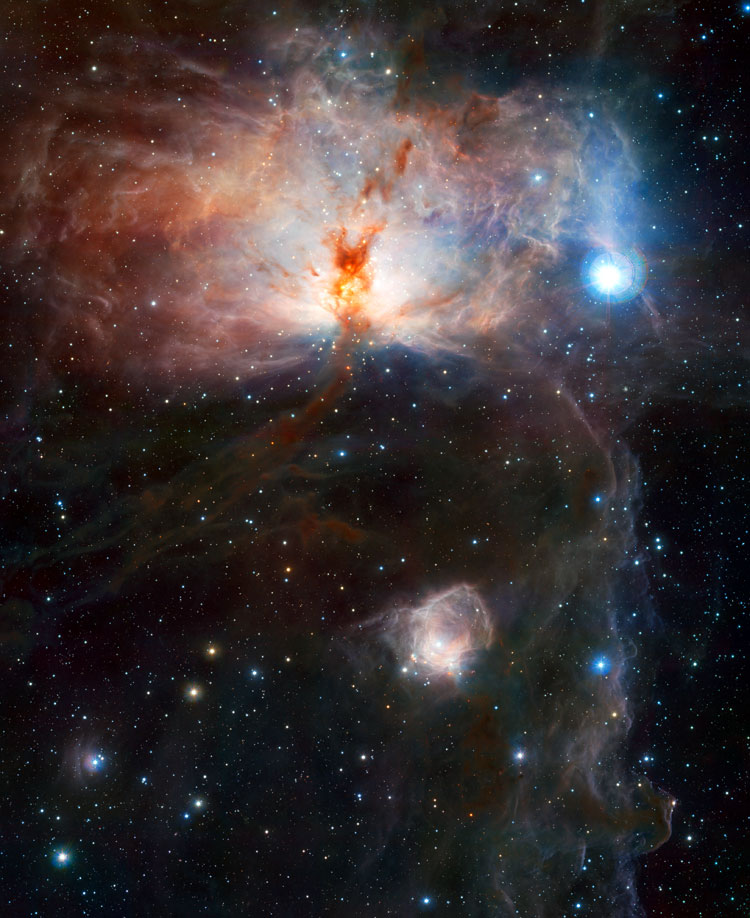
NGC 2025 (an OCL in the Large Magellanic Cloud)
Discovered (Feb 8, 1836) by John Herschel
A magnitude 10.9 open cluster in Mensa (RA 05 32 33.4, Dec -71 43 01)
Historical Identification: Per Dreyer, NGC 2025 (= GC 1228 = JH 2909, 1860 RA 05 34 48, NPD 161 47.4) is "very bright, very small, a little extended, gradually much brighter middle, mottled but not resolved".
Physical Information: In the Large Magellanic Cloud. Apparent size 1.9 arcmin.
NGC 2026
Discovered (Dec 5, 1784) by William Herschel
An open cluster in Taurus (RA 05 43 00.0, Dec +20 06 42)
Historical Identification: Per Dreyer, NGC 2026 (= GC 1229 = WH VIII 28, 1860 RA 05 34 49, NPD 69 57.7) is "a cluster, a little rich, a little compressed, stars pretty large (bright)".
Physical Information: Apparent size 10 arcmin.
NGC 2027 (an OCL in the Large Magellanic Cloud)
Discovered (Nov 6, 1826) by James Dunlop
Also observed (Nov 2, 1834) by John Herschel
A magnitude 11.9 open cluster in Dorado (RA 05 34 59.0, Dec -66 55 00)
Historical Identification: Per Dreyer, NGC 2027 (= GC 1230 = JH 2908, Dunlop 241, 1860 RA 05 35 04, NPD 157 00.5) is "a cluster, very large, rich, stars from 9th to 11th magnitude".
Discovery Note: Steinicke now lists this as Dunlop 193, but with the same discovery date as before.
Physical Information: NGC 2027 is listed as part of Lucke-Hodge stellar association 77, along with NGC 2002, 2006 and 2034, and SL objects 538, 582 and 586. It is also listed as part of Lucke-Hodge stellar association 84, along with NGC 2034. In the Large Magellanic Cloud. Apparent size 0.7 arcmin.
NGC 2028 (an OCL in the Large Magellanic Cloud)
Possibly observed (Sep 24, 1826) by James Dunlop
Discovered (Nov 12, 1836) by John Herschel
A magnitude 12.9 open cluster in Mensa (RA 05 33 48.2, Dec -69 57 05)
Historical Identification: Per Dreyer, NGC 2028 (= GC 1231 = JH 2912, Dunlop 100?, 1860 RA 05 35 11, NPD 160 02.4) is "very faint".
Discovery Note: Dunlop's observation is still considered uncertain (source?), and Steinicke does not list him as the discoverer.
Physical Information: NGC 2028 is listed as part of Lucke-Hodge stellar association 80. In the Large Magellanic Cloud. Apparent size 0.5 arcmin.
NGC 2029 (an EN in the Large Magellanic Cloud)
Discovered (Sep 27, 1826) by James Dunlop
Also observed (Nov 30, 1834) by John Herschel
An emission nebula in Dorado (RA 05 35 41.4, Dec -66 02 03)
Historical Identification: Per Dreyer, NGC 2029 (= GC 1232 = JH 2911, Dunlop 240, 1860 RA 05 35 20, NPD 157 38.7) is "pretty bright, pretty large, round, gradually brighter middle, in considerably large cluster".
Discovery Note: Steinicke lists this as Dunlop 219, not Dunlop 240, even though Dunlop 219 is also thought to probably or possibly be NGC 2032 or 2035. (source?)
Physical Information: NGC 2029 is listed as part of Lucke-Hodge stellar association 82, along with NGC 2032 and 2035 and e56 and e59. In the Large Magellanic Cloud.
NGC 2030 (an EN in the Large Magellanic Cloud)
Possibly discovered (1826) by James Dunlop
Discovered (Dec 23, 1834) by John Herschel
An emission nebula in Dorado (RA 05 34 59.9, Dec -67 33 19)
Historical Identification: Per Dreyer, NGC 2030 (= GC 1233 = JH 2910, (Dunlop 240), 1860 RA 05 35 27, NPD 156 06.8) is "pretty bright, large, irregularly round, gradually brighter middle, 1st of 3", the others being NGC 2032 and 2035.
Discovery Note: Steinicke now lists this as Dunlop 240, hence the addition of that to Dreyer's entry in parentheses. (source?)
Physical Information: NGC 2039 is listed as part of Lucke-Hodge stellar association 83, along with e61 and e63.
NGC 2031 (an OCL in the Large Magellanic Cloud)
Discovered (Nov 3, 1834) by John Herschel
A magnitude 10.8 open cluster in Mensa (RA 05 33 42.0, Dec -70 59 16)
Historical Identification: Per Dreyer, NGC 2031 (= GC 1234 = JH 2915, 1860 RA 05 35 34, NPD 161 05.4) is "a globular cluster, bright, pretty large, round, gradually brighter middle, partially resolved (some stars seen)".
Physical Information: In the Large Magellanic Cloud. Apparent size 3.4 arcmin.
NGC 2032 (an EN in the Large Magellanic Cloud)
Possibly observed (Sep 27, 1826) by James Dunlop
Discovered (Nov 2, 1834) by John Herschel
An emission nebula in Dorado (RA 05 35 20.3, Dec -67 34 38)
Historical Identification: Per Dreyer, NGC 2032 (= GC 1235 = JH 2913, Dunlop 219?, 1860 RA 05 35 40, NPD 157 39.8) is "bright, large, extended, 2nd of 3", the others being NGC 2030 and 2035.
Discovery Note: Steinicke now lists this as Dunlop 219, though he also lists that as NGC 2029 and 2035. (source?)
Physical Information: NGC 2032 is listed as part of Lucke-Hodge stellar association 82, along with NGC 2029 and 2035, and e56 and e59. In the Large Magellanic Cloud.
NGC 2033 (an OCL in the Large Magellanic Cloud)
?Discovered (Sep 24, 1826) by James Dunlop?
Discovered (1835) by John Herschel
A magnitude 11.6 open cluster in Dorado (RA 05 34 40.0, Dec -69 44 48)
Historical Identification: Per Dreyer, NGC 2033 (= GC 1236 = JH (579), (Dunlop 141), 1860 RA 05 35 45, NPD 159 52.5) is "a cluster, in Nubecula Major", Nubecula Major being the Large Magellanic Cloud.
Discovery Notes: Dunlop's observation was not identified until recently, hence its addition to Dreyer's entry in parentheses (however, although Steinicke previously listed this as Dunlop 141, he now does not list Dunlop at all, so once I've checked out other references, all mention of Dunlop may be removed from this entry). The parentheses around Herschel's observation mean that this was not in his general list of nebulae and clusters, but in his specialized list of objects in the Large Magellanic Cloud.
Physical Information: NGC 2033 is listed as part of Lucke-Hodge stellar association 81, along with NGC 2037 and e154. In the Large Magellanic Cloud. Apparent size 0.5 arcmin.
Per Corwin, NGC 2033 might be the cluster at RA 05 34 30.9, Dec -69 46 51
NGC 2034 (an OCL and EN in the Large Magellanic Cloud)
Discovered (Jan 3, 1837) by John Herschel
An open cluster and emission nebula in Dorado (RA 05 35 39.0, Dec -66 54 06)
Historical Identification: Per Dreyer, NGC 2034 (= GC 1237 = JH 2914, 1860 RA 05 35 52, NPD 156 58.7) is "a cluster, very large, rich".
Physical Information: NGC 2034 is listed as part of Lucke-Hodge stellar association 77, along with NGC 2002, 2006 and 2027, and SL objects 538, 582 and 586. NGC 2034 is also listed as part of Lucke-Hodge stellar association 84, along with NGC 2034. In the Large Magellanic Cloud.
NGC 2035 (an EN in the Large Magellanic Cloud)
Discovered (Aug 3, 1826) by James Dunlop
Also observed (Dec 23, 1834) by John Herschel
An emission nebula in Dorado (RA 05 35 32.2, Dec -67 35 16)
Historical Identification: Per Dreyer, NGC 2035 (= GC 1238 = JH 2916, Dunlop 220, 1860 RA 05 35 53, NPD 157 40.3) is "bright, large, round, brighter middle, 3rd of 3", the others being NGC 2030 and 2032.
Discovery Note: Apparently now thought to be Dunlop 219, not Dunlop 220, making this also the third object currently identified as probably or possibly Dunlop 219, the others being NGC 2029 and 2032 (Steinicke lists NGC 2035 as Dunlop 194, 219 and 242.). (sources?)
Physical Information: NGC 2035 is listed as part of Lucke-Hodge stellar association 82, alsong with NGC 2029 and 2032, and e56 and e59. In the Large Magellanic Cloud. Apparent size 3.0 by 3.0 arcmin.
NGC 2036 (an OCL in the Large Magellanic Cloud)
Discovered (Sep 24, 1826) by James Dunlop
Discovered (Nov 11, 1836) by John Herschel
A magnitude 12.8 open cluster in Mensa (RA 05 34 31.6, Dec -70 03 58)
Historical Identification: Per Dreyer, NGC 2036 (= GC 1239 = JH 2917, (Dunlop 102), 1860 RA 05 35 58, NPD 159 08.6) is "very faint, pretty large, round, gradually brighter middle".
Discovery Note: Steinicke now lists this as Dunlop 102, hence its addition (in parentheses) to Dreyer's entry.
Physical Information: In the Large Magellanic Cloud. Apparent size 0.6 arcmin.
NGC 2037 (an OCL in NGC 2033 in the Large Magellanic Cloud)
Discovered (Sep 24, 1826) by James Dunlop
Discovered (1835) by John Herschel
A magnitude 10.3 open cluster in Dorado (RA 05 34 54.0, Dec -69 44 12)
Corwin lists (in order of likelihood) RA 05 35 32, Dec -69 42 36; RA 05 34 59, Dec -69 44 30; and RA 05 34 40.2, Dec -69 44 50
Historical Identification: Per Dreyer, NGC 2037 (= GC 1240 = JH (593), 1860 RA 05 36 18, NPD 159 51.5) is "a cluster in Nubecula Major", Nubecula Major being the Large Magellanic Cloud.
Discovery Notes: Steinicke now lists this as Dunlop 141, hence its addition (in parentheses) to Dreyer's entry. The parentheses around Herschel's observation mean that this was not in his general list of nebulae and clusters, but in his specialized list of objects in the Large Magellanic Cloud.
Physical Information: NGC 2037 is listed as part of Lucke-Hodge stellar association 81, along with NGC 2033 and e154. In the Large Magellanic Cloud (near or overlapping NGC 2033). Apparent size 0.5 arcmin.
NGC 2038 (an OCL in the Large Magellanic Cloud)
Discovered (Nov 24, 1834) by John Herschel
A magnitude 11.9 open cluster in Mensa (RA 05 34 42.2, Dec -70 33 40)
Historical Identification: Per Dreyer, NGC 2038 (= GC 1241 = JH 2920, 1860 RA 05 36 24, NPD 160 38.4) is "pretty bright, small, round, gradually brighter middle, 9th magnitude star 5 arcmin to northwest".
Physical Information: In the Large Magellanic Cloud. Apparent size 1.7 arcmin.
NGC 2039
Discovered (Jan 8, 1828) by John Herschel
A group of stars in Orion (RA 05 44 33.0, Dec +08 39 24)
Historical Identification: Per Dreyer, NGC 2039 (= GC 1242 = JH 366, 1860 RA 05 36 26, NPD 81 25.6) is "a cluster, very large, a little rich, a little compressed".
Physical Information: Apparent size 55 arcmin.
NGC 2040 (an EN in the Large Magellanic Cloud)
Discovered (Sep 27, 1826) by James Dunlop
Also observed (Nov 2, 1834) by John Herschel
An emission nebula in Dorado (RA 05 36 06.4, Dec -67 33 57)
Historical Identification: Per Dreyer, NGC 2040 (= GC 1243 = JH 2918, (Dunlop 220), 1860 RA 05 36 28, NPD 157 39.1) is "faint, large, irregularly round, gradually a little brighter middle, mottled but not resolved".
Discovery Note: Apparently now thought to be Dunlop 220, hence its being added to Dreyer's entry in parentheses. (sources?)
Physical Information: NGC 2040 is listed as part of Lucke-Hodge stellar association 88, along with e56 and e59. In the Large Magellanic Cloud. Apparent size 3.0 by 3.0 arcmin.
NGC 2041 (an OCL in the Large Magellanic Cloud)
Discovered (Nov 6, 1826) by James Dunlop
Also observed (Nov 2, 1834) by John Herschel
A magnitude 10.4 open cluster in Dorado (RA 05 36 28.1, Dec -66 59 31)
Historical Identification: Per Dreyer, NGC 2041 (= GC 1244 = JH 2919, (Dunlop 241), 1860 RA 05 36 36, NPD 157 04.4) is "bright, small, round, very gradually a little brighter middle".
Discovery Note: Apparently now thought to be Dunlop 196 and 241, hence its being added to Dreyer's entry in parentheses. (sources?)
Physical Information: In the Large Magellanic Cloud. Apparent size 0.7 arcmin.
NGC 2042 (an OCL in the Large Magellanic Cloud)
Discovered (Sep 27, 1826) by James Dunlop
Also observed (Dec 30, 1836) by John Herschel
A magnitude 9.6 open cluster in Dorado (RA 05 36 46.0, Dec -68 55 30)
Corwin lists a star at RA 05 36 10.08, Dec -68 55 41, and three subclusters:
RA 05 36 09.6, Dec -68 55 24; RA 05 35 40.0, Dec -68 51 42; and RA 05 35 50.0, Dec -68 58 42
Historical Identification: Per Dreyer, NGC 2042 (= GC 1245 = JH 2922, (Dunlop), 1860 RA 05 37 02, NPD 159 00.3) is "a cluster, very large, rich, stars from 12th to 15th magnitude".
Discovery Note: Steinicke now lists this as Dunlop 137, 181 and 183, hence his name being added to Dreyer's entry in parentheses. (sources?)
Physical Information: NGC 2042 is listed as part of Lucke-Hodge stellar association 89, along with e135. In the Large Magellanic Cloud. Apparent size 9 arcmin.
NGC 2043 (an OCL in the Large Magellanic Cloud)
Discovered (Dec 18, 1884) by Pietro Baracchi
An open cluster in Mensa (RA 05 35 33.9, Dec -70 07 26)
Corwin also lists a star cloud centered at RA 05 35 24.0, Dec -70 07 18
Historical Identification: Per Dreyer, NGC 2043 (Melbourne Observatory, 1860 RA 05 37 05, NPD 160 10.1) is "small, extended group of faint stars involved in faint nebulosity".
Discovery Note: Baracchi was third assistant at Melbourne Observatory and in charge of the Great Melbourne Telescope from 1883 to 1892, and therefore at the time of this discovery.
Physical Information: In the Large Magellanic Cloud.
NGC 2044 (an OCL in the Large Magellanic Cloud)
Discovered (1835) by John Herschel
A magnitude 10.6 open cluster in Dorado (RA 05 36 06.4, Dec -69 11 47)
Corwin lists the above as three (sub?)clusters, and NGC 2044 as RA 05 35 57.0, Dec -69 11 24
Historical Identification: Per Dreyer, NGC 2044 (= GC 1246 = JH (608), 1860 RA 05 37 08, NPD 159 17.5) is "a cluster in Nubecula Major", Nubecula Major being the Large Magellanic Cloud.
Discovery Notes: The parentheses around Herschel's observation mean that this was not in his general list of nebulae and clusters, but in his specialized list of objects in the Large Magellanic Cloud.
Physical Information: NGC 2044 is listed as part of Lucke-Hodge stellar association 90, along with e135 and e157. In the Large Magellanic Cloud. Apparent size 2.0 arcmin.
NGC 2045 (= SAO 94827)
Recorded as a star ("1801") by Joseph Lalande
Recorded (Jan 23, 1832) by John Herschel
A magnitude 6.5 star in Taurus (RA 05 45 01.3, Dec +12 53 18)
Historical Identification: Per Dreyer, NGC 2045 (= GC 1247 = JH 367, Lalande 10842, 1860 RA 05 37 09, NPD 77 10.5) is "a magnitude 8 or 9 star with faint nebulosity".
Discovery Note: The date listed for Lalande is the publication date for his Histoire Céleste.
Physical Information:
NGC 2046 (an OCL in the Large Magellanic Cloud)
Discovered (Nov 11, 1836) by John Herschel
A magnitude 12.6 open cluster in Mensa (RA 05 35 38.6, Dec -70 14 26)
Historical Identification: Per Dreyer, NGC 2046 (= GC 1248 = JH 2923, 1860 RA 05 37 11, NPD 160 19.0) is "very faint, round, gradually brighter middle, 1st of 7", the others being NGC 2047, 2057, 2058, 2059, 2065 and 2066.
Physical Information: In the Large Magellanic Cloud. Apparent size 1.3 arcmin.
NGC 2047 (an OCL in the Large Magellanic Cloud)
Discovered (Nov 11, 1836) by John Herschel
A magnitude 13.2 open cluster in Mensa (RA 05 35 54.0, Dec -70 11 32)
Historical Identification: Per Dreyer, NGC 2047 (= GC 1249 = JH 2925, 1860 RA 05 37 27, NPD 160 16.3) is "faint, small, a little extended, 2nd of 7", the others being NGC 2046, 2057, 2058, 2059, 2065 and 2066.
Physical Information: In the Large Magellanic Cloud. Apparent size 0.8 arcmin.
NGC 2048 (an EN and star in the Large Magellanic Cloud)
Possibly observed (Sep 24, 1826) by James Dunlop
Also observed (Nov 11, 1836) by John Herschel
An emission nebula and star in Dorado (RA 05 35 55.8, Dec -69 38 53)
Historical Identification: Per Dreyer, NGC 2048 (= GC 1250 = JH 2926, (Dunlop 141), 1860 RA 05 37 36, NPD 159 41.7) is "very faint, large, pretty much extended".
Discovery Note: Steinicke previously listed this as Dunlop 141, hence its being added to Dreyer's entry in parentheses, but he no longer lists Dunlop as the discoverer. (sources?)
Physical Information: NGC 2048 is listed as part of Lucke-Hodge stellar association 87, along with e154. In the Large Magellanic Cloud. Apparent size 0.5 arcmin.
NGC 2049 (= PGC 17657)
Discovered (Jan 28, 1835) by John Herschel
A magnitude 12.7 spiral galaxy (type Sa) in Columba (RA 05 43 15.3, Dec -30 04 42)
Historical Identification: Per Dreyer, NGC 2049 (= GC 1251 = JH 2921, 1860 RA 05 37 53, NPD 120 08.7) is "very faint, small, round, brighter middle".
Physical Information: Apparent size 2.0 by 1.0 arcmin.
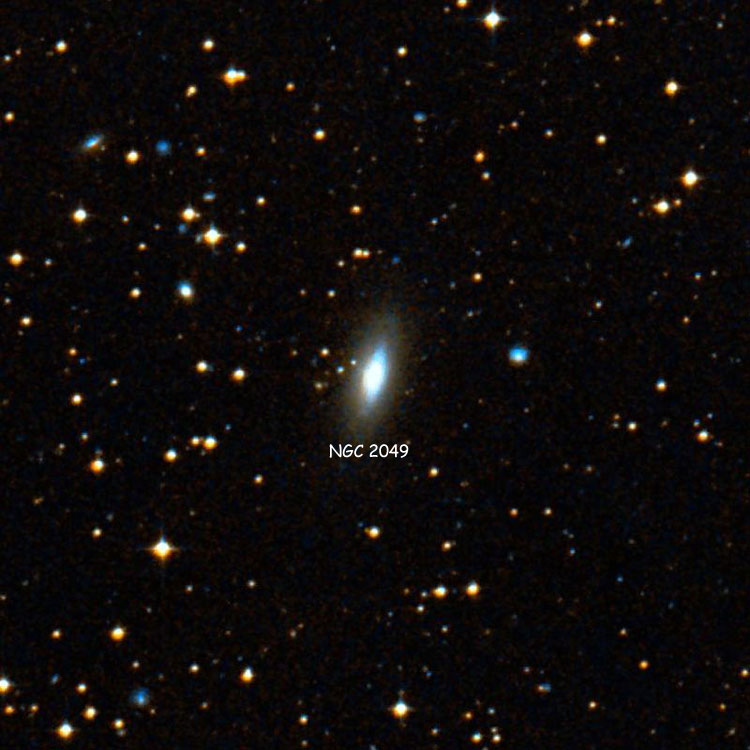
Above, a 12 arcmin wide DSS image centered on NGC 2049
Below, a 2.4 arcmin wide DSS image of the galaxy
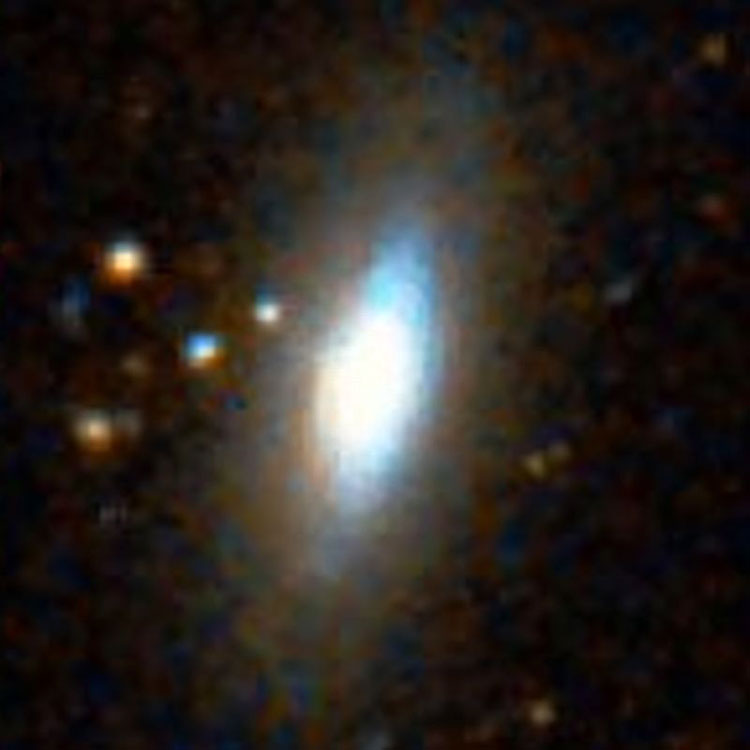
|